Samaaro + Your CRM: Zero Integration Fee for Annual Sign-Ups Until 30 June, 2025
- 00Days
- 00Hrs
- 00Min
Picture this scene: a bustling conference hall filled with enthusiastic attendees, lively conversations buzzing around every corner. Speakers on stage are captivating the audience, brand representatives are building connections, and the energy is electric. This isn’t just a successful event; it’s a springboard for creating lasting relationships and driving customer loyalty. In today’s digital marketing landscape, where attention spans are fleeting and competition is fierce, events stand out as powerful tools for forging genuine connections with your target audience.
Events offer a unique opportunity to transcend the limitations of traditional marketing channels. They create immersive brand experiences that go beyond static ads and promotional emails. The attendees can interact with your brand on a personal level, engage with industry leaders, and gain valuable insights. This creates brand awareness, generates excitement, and cultivates a sense of community.
Why Event Marketing Matters
Strategic event marketing delivers several benefits that extend far beyond the event itself. It allows you to:
What If You Are New to Event Marketing
While event marketing can be incredibly rewarding, it’s natural to feel overwhelmed when starting. Limited resources, navigating unfamiliar territory, and the sheer number of moving parts can be daunting. Don’t worry! This comprehensive guide will serve as your roadmap to navigate the event marketing landscape with confidence.
Understanding the Essentials

Before diving headfirst into promoting your event, it’s crucial to lay a solid base. This essential phase of event marketing involves understanding your target audience, setting SMART goals, and selecting the most effective marketing channels to reach them. By crafting a strategic marketing plan, you can optimize your budget allocation and ensure your efforts translate into measurable results. Let’s begin with what your ideal attendee should look like.
1. Who’s Your Ideal Attendee? Visibility
The foundation of any successful event marketing strategy rests on a clear understanding of your target audience. These are the people you want to attract to your event – potential customers who would benefit from your brand’s offerings. Define your ideal attendee by considering:
By creating buyer personas – detailed profiles representing your ideal attendees – you can personalize your marketing efforts and ensure your message resonates with the right audience.
2. Setting SMART Goals
Events shouldn’t be throwaway affairs. Clearly defined goals provide direction and ensure your event marketing efforts are targeted and measurable. Utilize the SMART goals framework:
3. Marketing Channels for Maximum Visibility

The key to successful event promotion lies in a strategic multi-channel approach. Utilize a mix of traditional and digital channels to reach your target audience where they spend their time.
Traditional Channels:
Digital Channels:
4. Crafting Your Event Marketing Strategy
A successful event isn’t just about the day itself. It’s a carefully planned journey that begins with building anticipation, followed by enhancing attendee engagement, and culminating in nurturing long-term relationships. To achieve this, you need a strategic event marketing plan that encompasses all three stages: pre-event, during-event, and post-event.
A. Pre-Event: Building Momentum

The months leading up to your event are crucial for creating buzz and generating excitement. Here’s how to strategically promote your event:
Develop a user-friendly website with clear information about the event, speakers, agenda, and registration process. At the same time, include high-quality visuals and testimonials to create a positive first impression. Conversely, you can use the functionalities of event tech software like Samaaro’s website builder to create stunning, informative event websites effortlessly.
Utilize social media platforms to become a hub for event information and engagement. Partner with relevant influencers to share their perspectives and generate excitement. In addition, develop a content calendar with a mix of:
Email marketing remains a powerful tool for targeted outreach, which you need to utilize wisely. First, segment your email list based on demographics and interests for personalized messaging. Next, create engaging email sequences with clear calls to action (CTAs) to encourage registration. Lastly, offer exclusive early-bird discounts or bonus materials to incentivize early registration.
Develop a PR strategy to generate media coverage and reach a wider audience. For instance, reach out to industry publications and journalists relevant to your target audience. Secure sponsorships that can provide financial support and additional promotional opportunities. Afterward, craft compelling press releases highlighting the event’s key aspects and speakers.
During-Event: Keeping the Flame Alive

Maintaining momentum and promoting engagement are key during the event itself. Utilize tools and strategies to keep the attendees actively participating:
Encourage social media interaction by live streaming key sessions to reach the virtual attendees. Simultaneously, create an event hashtag to track conversations and encourage attendee participation. Also run contests and giveaways on social media platforms to incentivize real-time engagement.
Enhance the event experience with clear signage directing the attendees to different locations and sessions. Moreover, utilize interactive elements like live polls, Q&A sessions, and networking opportunities. Finally, set dedicated social media walls showcasing attendee posts and event highlights.
Post-Event: Cultivating Long-Term Relationships

Don’t let the post-event lull diminish the impact. Capitalize on the momentum and nurture relationships with the attendees through different strategies:
Rekindle the excitement by sharing the events’ highlights, photos, and video recordings on social media and your website. Publish blog posts summarizing key takeaways from the event in addition to featuring the attendees’ testimonials and positive feedback.
Gather valuable insights for future events by conducting post-event surveys to collect the attendees’ feedback on content, logistics, and overall experience. Even so, analyze the data on website traffic, social media engagement, and lead generation.
Convert attendees into loyal customers by sending personalized follow-up emails based on the attendees’ interests and sessions attended. Offer exclusive post-event discounts or special offers besides inviting them to join your email list or social media community for ongoing engagement.
Repurpose valuable content from your event to extend its reach. Transform the video recordings of sessions into bite-sized clips for social media or your YouTube channel. Next, create blog posts or infographics summarizing key takeaways from different sessions. In the end, utilize the event presentations and materials as lead magnets for future marketing campaigns.
5. Budgeting and Measurement for Success
Event marketing doesn’t have to break the bank. Here’s how to budget effectively:
6. Measuring The Event’s Impact
It’s crucial to track key event marketing metrics (KPIs) to understand the effectiveness of your efforts. This data allows you to measure your success and continuously improve future events. Here are some key event marketing KPIs:
Actionable Steps to Launch Your Event Marketing
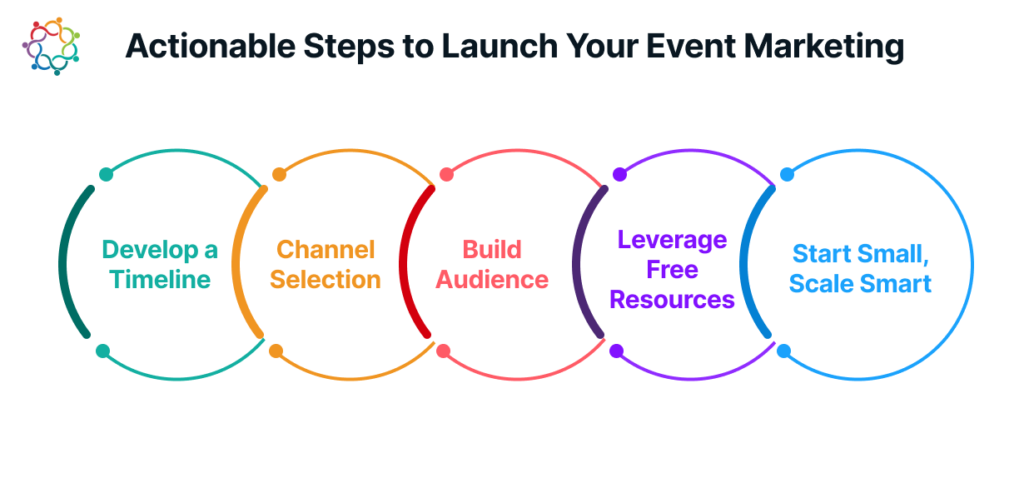
Now that you’re equipped with the fundamentals of event marketing, it’s time to take action. Here’s a roadmap to get you started:
Outline a clear timeline for your event marketing activities. Backwards planning can be helpful. Start with your event date and work backward to identify key milestones and deadlines for each promotional phase (e.g., pre-event launch date, social media campaign start date, email sequence schedule, etc.)
2. Channel Selection:
Research and choose the marketing channels that best align with your target audience, budget, and event goals. Don’t spread yourself too thin – focus on mastering a few key channels initially.
3. Build Your Audience:
Utilize the chosen marketing channels to start building your event audience well in advance. Create engaging content, share valuable insights, and nurture communication to generate interest and excitement for your event.
4. Leverage Free Resources:
Take advantage of free or low-cost marketing tools like social media scheduling platforms (e.g., Hootsuite, Buffer) or email marketing automation software (e.g., Mailchimp) to streamline your marketing efforts and optimize the resource allocation.
5. Start Small, Scale Smart:
Don’t be afraid to start with a smaller-scale event to test your event marketing strategies. As you gain experience and confidence, you can scale up your events and marketing efforts for even greater impact.
Conclusion
Strategic event marketing is a powerful tool for any business looking to cultivate lasting relationships with its target audience. By understanding your ideal attendee, setting clear goals, and employing effective marketing strategies, you can transform your event into a springboard for brand awareness, engagement, and ultimately, customer loyalty. Remember, successful event marketing isn’t just about the event itself; it’s about nurturing long-term customer relationships that drive sustainable growth.
Start planning your event marketing strategy today and discover the potential to connect with your audience in a meaningful and impactful way. Ready to elevate your events? Book a demo and start your free trial today!
Tradeshows can be a powerful platform for businesses to showcase their products or services, network with industry professionals, and generate leads. However, with thousands of exhibitors vying for attendee attention, it’s essential to avoid common mistakes that can hinder your success. This guide will highlight key pitfalls to watch out for and provide strategies for a successful tradeshow experience.
By investing time and effort into the planning and preparation stages, you can lay the foundation for a memorable and impactful event. Effective planning ensures that all aspects of your tradeshow, from booth design to marketing efforts, are well-executed, maximizing your chances of success. This section will highlight the common mistakes that can hinder your success and how to avoid them.
Failing to promote your tradeshow presence well in advance can have serious consequences. Not only can it lead to low attendance, but it can also limit your ability to connect with potential customers and partners, reduce your return on investment, and miss out on valuable networking opportunities. By starting your pre-event marketing efforts early, you can build anticipation, attract a larger audience, and increase the chances of achieving your desired business goals.
Avoid setting overly ambitious goals for your tradeshow participation. Instead, focus on realistic expectations based on factors such as your company’s size, the industry and target audience, previous tradeshow performance, and the overall event’s reputation and attendance. Setting achievable goals will help you avoid disappointment and focus on making gradual progress towards your objectives.
Failing to prepare your staff with product knowledge, effective communication skills, and customer service training can negatively impact your booth’s success. Ensure your team is equipped to engage with the attendees, answer questions, and address any concerns. Provide them with comprehensive training in product knowledge, sales techniques, customer service, and company culture and values.
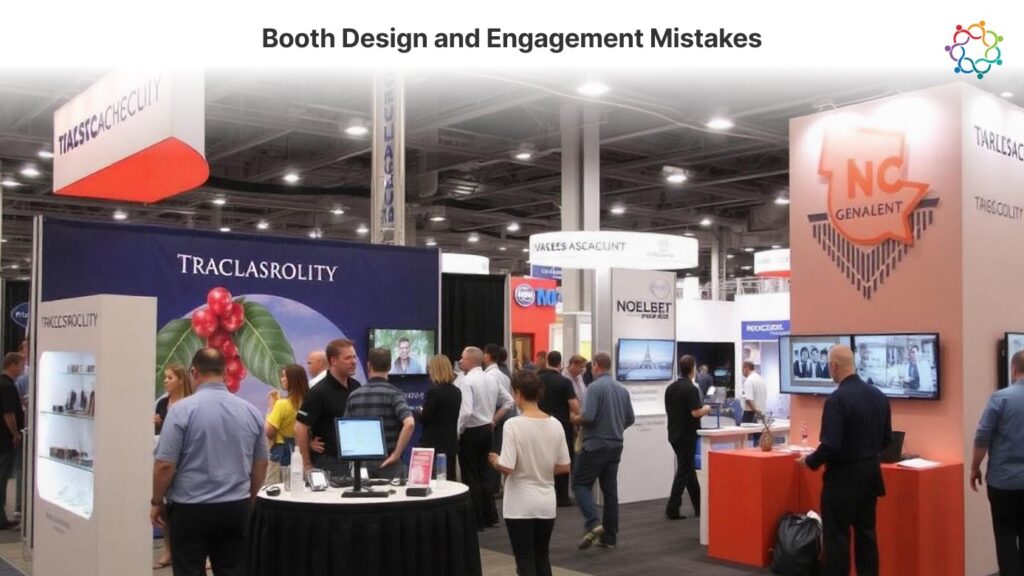
A visually unappealing or poorly organized booth can significantly impact your success at a tradeshow. That’s why it’s important to create a memorable and effective booth to attract attendees, encourage engagement, and create a positive impression of your brand. This section will highlight key pitfalls to watch out for and provide strategies for creating a memorable and effective booth experience.
A lackluster booth design can fail to capture attendee attention and interest. Instead, focus on creating a visually appealing and engaging booth that reflects your brand identity and invites attendees to interact with your products or services. To create a memorable and effective booth, focus on visual appeal, clear signage, efficient layout, interactive elements, consistent branding, comfort and functionality, and accessibility.
Avoid simply setting up a booth and waiting for attendees to come to you. Actively engage attendees by initiating conversations, offering demonstrations, or providing valuable content. By personalizing your interactions and tailoring your approach to each attendee’s needs, you can create a more memorable and impactful tradeshow experience.
Incorporate interactive displays, demonstrations, or activities to make your booth more engaging and memorable. This could include hands-on product demos, interactive games, touchscreen displays, or virtual reality experiences that engage attendees effectively and make your booth stand out.
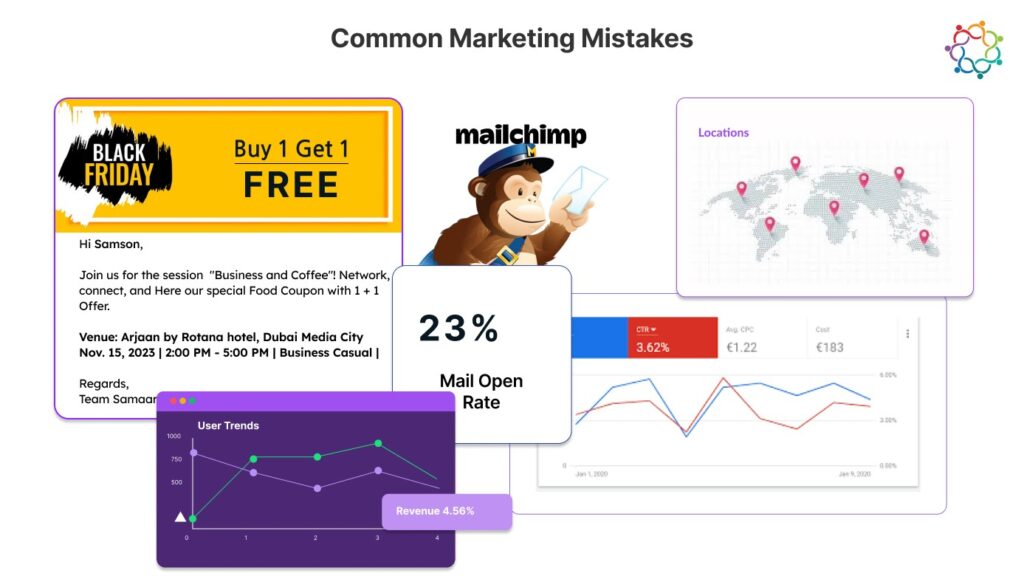
When planning and executing a tradeshow, it’s essential to avoid common marketing mistakes that can hinder your success. By understanding and addressing these pitfalls, you can optimize your efforts and achieve maximum impact. This section will delve into some of the most common marketing mistakes made by tradeshow exhibitors and provide strategies for avoiding them.
While traditional marketing channels can be effective, relying solely on them can limit your reach and engagement. You need to incorporate digital marketing strategies to reach a wider audience, target specific demographics, and track the effectiveness of your efforts.
Leverage social media to build relationships with potential attendees, email marketing to send targeted email campaigns to your existing database, and content marketing to publish valuable content and establish yourself as an industry expert.
Social media platforms offer a powerful way to connect with your target audience, build brand awareness, and generate excitement for your tradeshow presence. Therefore, interact with potential attendees by responding to comments, messages, and questions promptly. Make sure to create engaging content, use relevant hashtags, and offer incentives to maximize your reach and encourage participation.
Without proper tracking and analysis, it’s difficult to assess the effectiveness of your tradeshow marketing efforts. Use analytics tools to monitor key metrics such as website traffic to gauge interest, social media engagement to measure the impact of your social media campaigns, and ROI to track lead generation. This data will help you identify areas for improvement and optimize your future strategies.
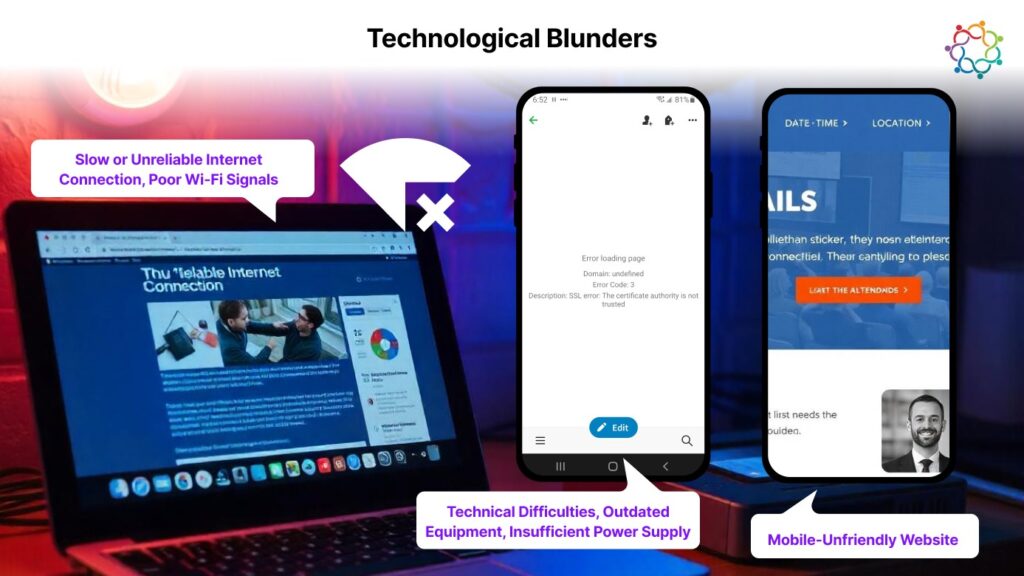
When planning and executing your tradeshow, it’s essential to avoid technological blunders that can disrupt your booth operations, frustrate attendees, and hinder your overall success. This section will highlight common technological mistakes and provide tips for preventing them.
Outdated equipment, insufficient power supply, and network connectivity issues can disrupt your booth operations and frustrate attendees. Ensure your technology is up-to-date and reliable, with adequate power sources and a strong network connection to avoid technical difficulties and provide a smooth event experience.
A slow or unreliable internet connection can cause significant problems at tradeshows. Poor Wi-Fi signals, network congestion, and data usage limits can all lead to delays, frustrations, and disruptions. It’s essential to have a strong and reliable internet connection to ensure smooth operations and a positive attendee experience.
Lack of mobile optimization can hinder your ability to reach and engage with attendees. A website that is not optimized for mobile devices may be difficult to navigate and use on smartphones and tablets, leading to a decrease in engagement and interest. By ensuring your website and marketing materials are mobile-friendly, you can reach a wider audience and provide a better user experience.
Conclusion
By avoiding these common mistakes and implementing effective strategies, you can ensure a successful tradeshow experience and maximize your return on investment. Remember to plan ahead, design a memorable booth, engage with attendees effectively, and leverage technology to enhance your presence. With careful preparation and execution, you can stand out in a crowded tradeshow environment and achieve your business goals. Book a demo and start your free trial today to take your tradeshow strategy to the next level!
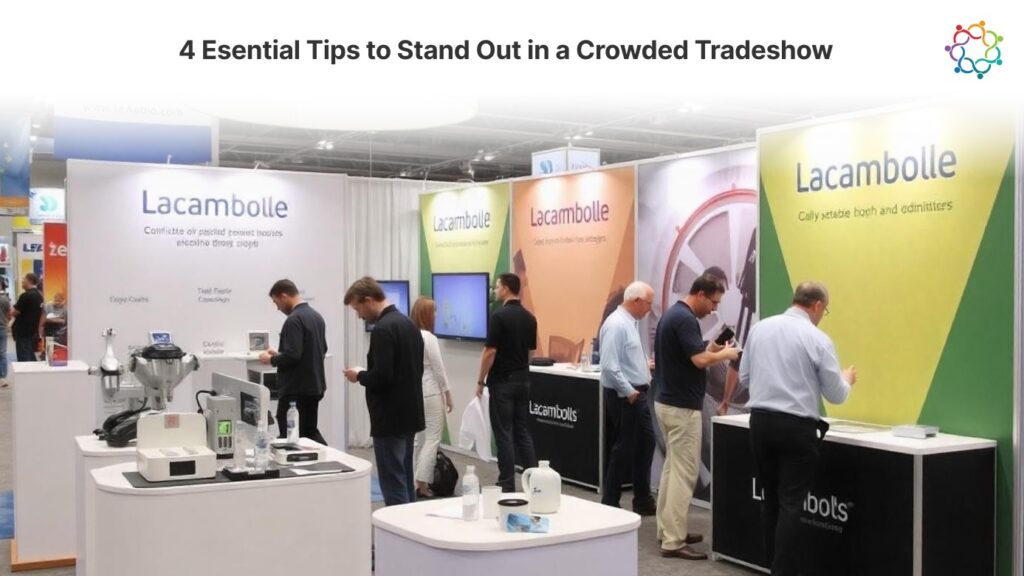
Tradeshows offer a unique opportunity for businesses to showcase their products or services, network with industry professionals, and generate leads. However, with thousands of exhibitors vying for attendee attention, it’s essential to have a well-crafted marketing strategy to stand out and achieve your goals. This comprehensive blog will provide you with valuable insights and tips to ensure your tradeshow participation is a resounding success.
Effective planning and preparation are essential for a successful tradeshow experience. This section talks about crucial points for ensuring that your tradeshow participation is well-planned and executed
To ensure your tradeshow participation is successful, it’s essential to define clear and specific goals. Identify what you hope to achieve, such as increasing brand awareness, generating leads, building relationships, or showcasing new products. These goals should align with your overall business strategy and be measurable, so you can track your progress and evaluate success. Consider setting SMART goals (Specific, Measurable, Achievable, Relevant, and Time-bound) to ensure they are focused and actionable.
Identify your ideal attendees by considering their demographics, interests, and pain points. This information will help you tailor your marketing efforts and create content that resonates with them. You also need to research past attendee data to understand their preferences and behaviors and use this knowledge to inform your tradeshow strategy.
Select a tradeshow that aligns with your industry and attracts your target audience. Consider factors such as the tradeshow’s reputation, size, and focus. Additionally, evaluate the location and timing of the event to ensure it is convenient for your target audience and aligns with your business calendar. It is important to review past attendance, exhibitor feedback, and event success metrics to make an informed decision.
Design a booth that stands out and attracts attention. Use eye-catching visuals, interactive elements, and clear signage to create a memorable experience for attendees. Plus, optimize your booth layout for maximum visibility and ensure it aligns with your brand identity. Consider incorporating interactive displays, demonstrations, or activities to engage the attendees and showcase your products or services.
Equip your staff with the knowledge and skills they need to not only succeed at the tradeshow but also represent your brand effectively. In addition to providing them with in-depth training on your products or services, make sure they are well-versed in effective sales techniques and excellent customer service. Furthermore, ensure they understand your company’s values and culture so they can represent your brand positively.
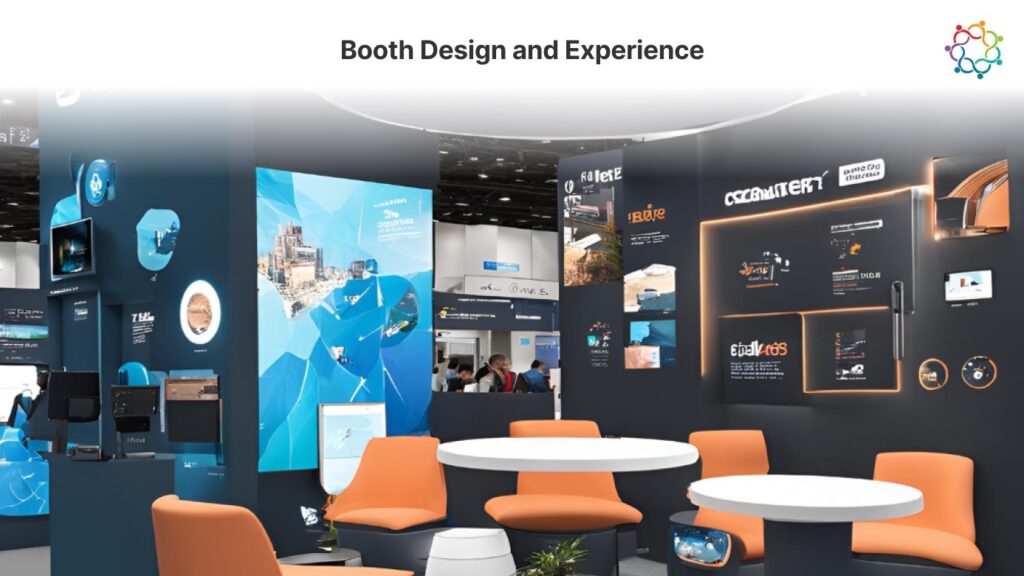
A well-designed and engaging booth is essential for attracting attendees and making a lasting impression at a tradeshow. This section will discuss the key factors to consider when designing your booth, incorporating interactive elements, and creating a welcoming atmosphere that encourages attendee engagement.
Design your booth to be visually appealing and consistent with your brand identity, using eye-catching graphics, branding elements, and lighting. At the same time, ensure the layout is practical and efficient, allowing for easy movement and interaction. Consider factors such as traffic flow, product display, and seating areas to create a welcoming and inviting atmosphere.
Incorporate interactive elements like virtual reality (VR) or augmented reality (AR) to provide attendees with unique and engaging experiences. For example, you could use VR to showcase product demonstrations or AR to allow attendees to visualize products in their own space. Additionally, digital screens can be used to display product information, promotional messages, and multimedia content, capturing attention and providing valuable information. Finally, developing a dedicated event app can enhance the attendee engagement by offering personalized recommendations, networking tools, and real-time updates.
To attract and retain attendees, offer valuable content that goes beyond simply showcasing your products or services. Consider organizing workshops, seminars, or panel discussions on relevant topics, inviting industry experts to share their knowledge, or offering product demonstrations to showcase your offerings in action. By providing attendees with valuable content, freebies, and giveaways, you’re more likely to capture their interest, incentivize engagement, and create a memorable experience.
Ensure your booth staff is well-trained, knowledgeable about your products or services, and approachable to the attendees. Provide comfortable seating areas and amenities such as refreshments or charging stations to enhance the attendee experience. Make an effort to engage with each attendee individually, offering personalized recommendations or assistance as needed.
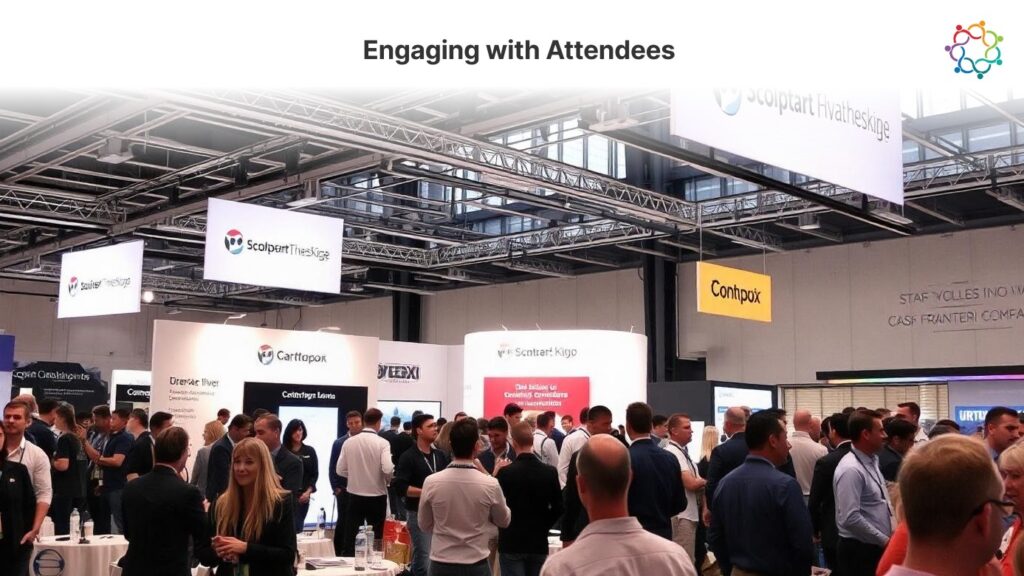
Engaging with attendees is a crucial aspect of a successful tradeshow experience. This section will explore strategies for engaging with attendees and maximizing your booth’s impact.
Actively listen to the attendees’ questions and concerns to effectively engage with them. Also ask open-ended questions to encourage them to share their experiences and perspectives and adapt your communication style to suit different individuals and their interests. By demonstrating genuine interest, encouraging open dialogue, and tailoring your approach, you can create a more engaging and personalized experience for the attendees.
Consider organizing social gatherings or receptions, introducing attendees to relevant industry professionals or potential partners, and creating a welcoming and inclusive atmosphere to facilitate networking among attendees. These strategies can help attendees connect with like-minded individuals, build relationships, and explore potential collaborations.
Use a customer relationship management (CRM) system to collect attendee data efficiently and ethically and an event app to gather data in real-time. Offer incentives, such as discounts or giveaways, in exchange for contact information. And most importantly, ensure that the attendee data is collected and used in compliance with privacy regulations.
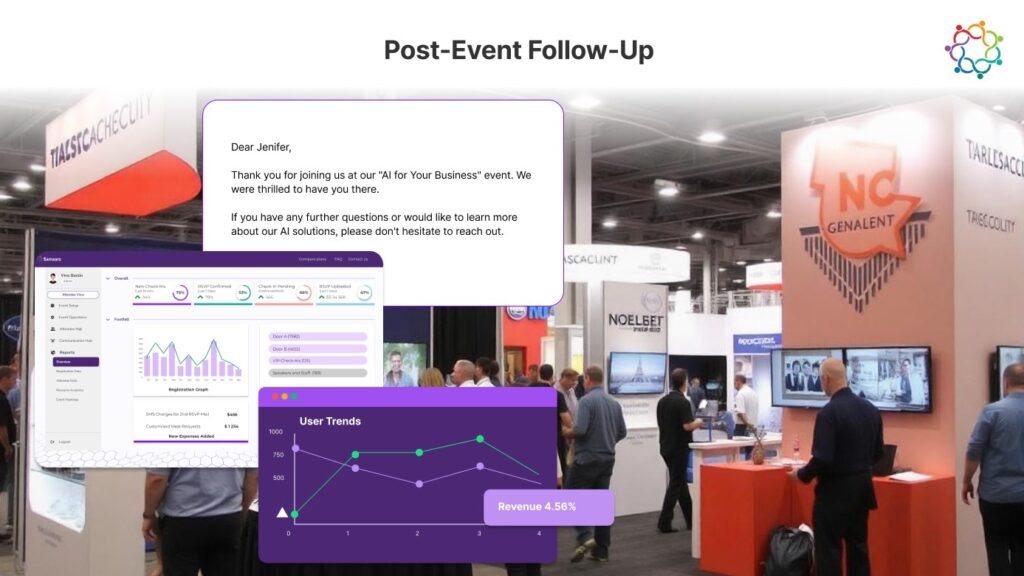
A successful tradeshow doesn’t end when the event concludes. Effective post-event follow-up is crucial for nurturing leads, building relationships, and maximizing your return on investment. This section will discuss the importance of sending thank-you notes, following up with potential customers, and analyzing your event’s performance to inform future strategies.
Send personalized thank-you notes to attendees, addressing them by name and referencing specific interactions or conversations. Don’t forget to recap the highlights of your interaction and the value they gained. Offer additional resources, such as whitepapers, case studies, or blog posts, to continue the conversation. Finally, include a link to a short survey to gather attendee feedback and insights for future improvements.
To maximize the potential of leads generated at your tradeshow, segment them based on their level of interest and potential value. This will help you tailor your follow-up efforts and provide the most relevant information and resources. Next, create personalized follow-up plans for each lead segment, including specific actions, timelines, and content to share. Then, provide value to leads by offering additional information, resources, or invitations to future events. Lastly, track lead engagement and progress through the sales funnel to measure the effectiveness of your follow-up efforts.
Track key performance indicators (KPIs) such as booth traffic, lead generation, attendee engagement, and return on investment (ROI) to measure the success of your tradeshow participation. Compare these results to your pre-event objectives to identify areas of strength and weakness. Subsequently, analyze the feedback from attendees and staff to gain valuable insights for future events. Remember to share your findings with your team to inform future marketing strategies and optimize your tradeshow presence.
By following these strategies and continuously adapting your approach, you can maximize your tradeshow participation and achieve your business goals. Remember, a successful tradeshow experience is about more than just attending the event. It’s about effectively engaging with your target audience, building relationships, and driving results. Book a demo and start your free trial of Samaaro’s platform today to enhance your tradeshow strategy and drive even greater success!
Imagine pouring your heart and soul into planning an event, but the impact is unclear. Were your efforts a hit, or a miss? This happens all too often when event organizers fail to track and measure success. But it is possible to overcome this situation. By focusing on Key Performance Indicators (KPIs), you can transform your event from a guessing game into a data-driven triumph.
The challenge for event organizers lies in accurately gauging the impact of their efforts. Did your marketing campaign reach the right audience? Were attendees engaged during the event? Without measurable data, it’s impossible to answer these questions and improve future events.
KPIs are the solutions for these problems. They provide valuable insights into various aspects of your event, allowing you to identify strengths, weaknesses, and areas for improvement.
Tracking KPIs unlocks a treasure trove of benefits. It lets event organizers maximize return on investment (ROI), boost attendee engagement, and plan future events with laser focus. KPIs equip you with the knowledge and power to achieve these goals and more.
In this blog, we’ll explore five essential metrics that will transform your event optimization journey:
KPIs, or Key Performance Indicators, are quantifiable metrics that track your progress towards achieving specific event goals.
SMART Goals
Before diving into KPIs, it’s crucial to establish SMART goals (Specific, Measurable, Achievable, Relevant, and Time-bound). These goals act as a roadmap, guiding you in choosing relevant KPIs to track success. For example, a SMART goal could be “Increase event registration by 20% within the next quarter.” The corresponding KPI would be the “Registration Rate.”
Metrics vs. KPIs
It’s important to distinguish between metrics and KPIs. Metrics are raw data points, like the number of website visitors. KPIs, however, tell a story. By analyzing metrics (e.g., website traffic) and interpreting them through the lens of KPIs (e.g., attendee engagement), you gain valuable insights into your event’s effectiveness.
A. Pre-Event KPIs
The groundwork for a successful event is laid well before the first attendee arrives. Pre-event KPIs offer a crucial window into the effectiveness of your marketing efforts, audience engagement, and overall event readiness.
1. Registration Rate
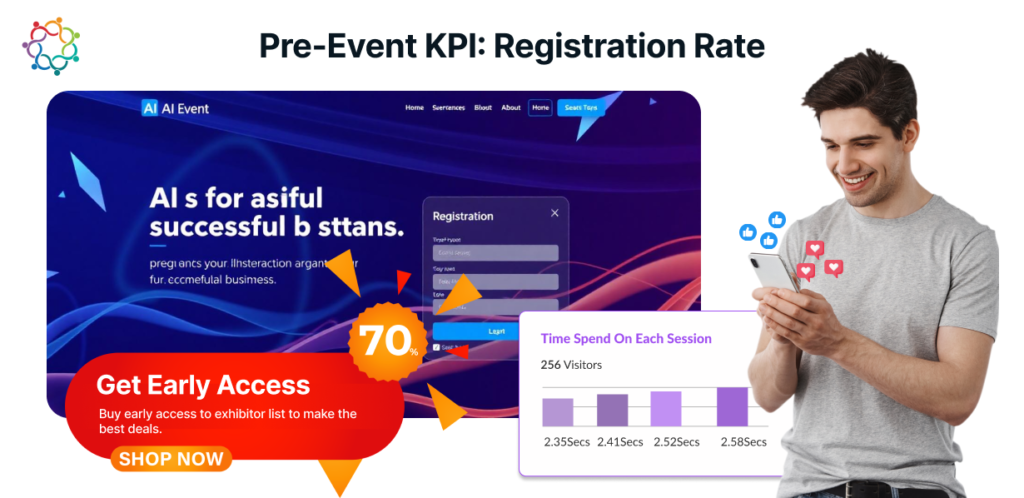
The registration rate simply refers to the percentage of website visitors who convert into registered attendees for your event. Mathematically, it’s calculated as:
Registration Rate = (Number of Registered Attendees) / (Total Number of Unique Website Visitors) x 100
This metric provides a quick snapshot of how well your event website and marketing efforts are enticing visitors to take the next step and commit to attending.
Strategies to Boost Registration Rates
Here are some key strategies to significantly improve your registration rate:
Importance of Registration Data Analysis
Analyzing the registration data goes beyond a simple percentage. By digging deeper, you can gain valuable insights that inform future event planning:
2. Website Traffic and Engagement
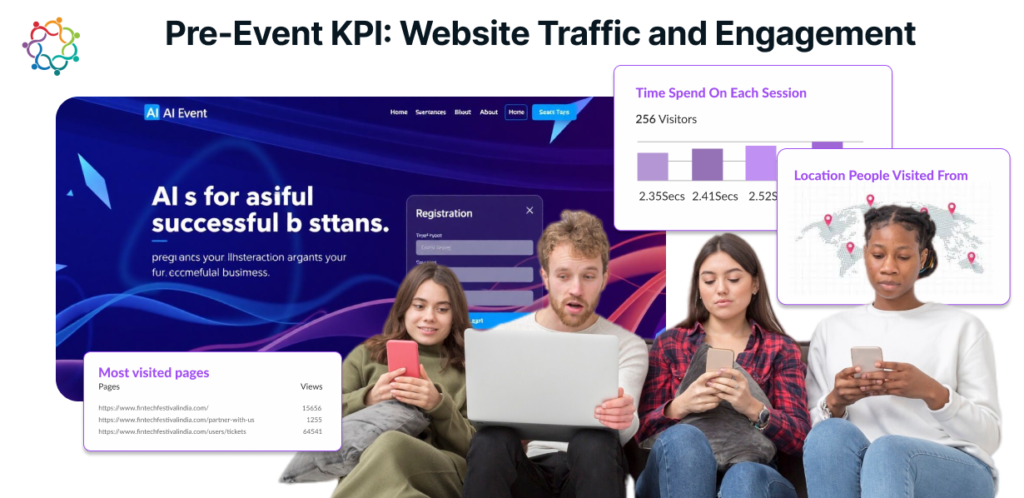
Website traffic and engagement metrics provide a window into how visitors interact with your website, revealing valuable insights into their needs and preferences.
How Engagement Metrics Guide Website Optimization
By analyzing website traffic and engagement data, you gain valuable insights into:
How Website Data Drive Personalized Marketing Efforts
Website data empowers you to personalize your marketing efforts and convert visitors into registered attendees:
B. During-Event KPIs:
During-event KPIs serve as a real-time pulse check on your event’s effectiveness. This allows you to identify areas for improvement on the fly and optimize the event experience in real-time.
3. Event Check-In Rates
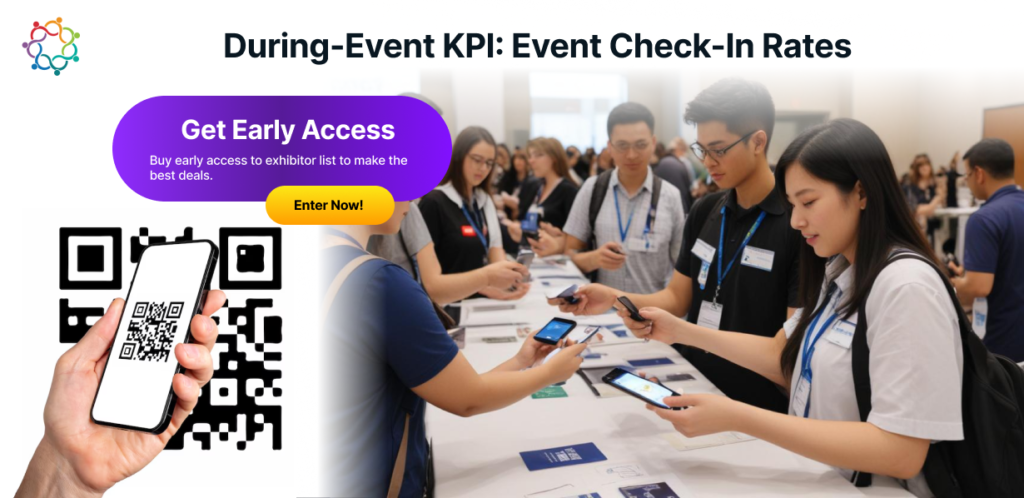
Tracking check-in rates lets you gauge how many registered attendees actually participate in your event. Low check-in rates might indicate logistical issues or last-minute cancellations.
Check-In Improvement Strategies
Low check-in rates can be frustrating for both the attendees and event organizers. Here are some strategies to ensure a smooth and efficient check-in process:
Importance of Check-In Data Analysis
Analyzing check-in data goes beyond raw numbers. By diving deeper, you can identify areas for improvement in future events:
4. Session Attendance and Engagement
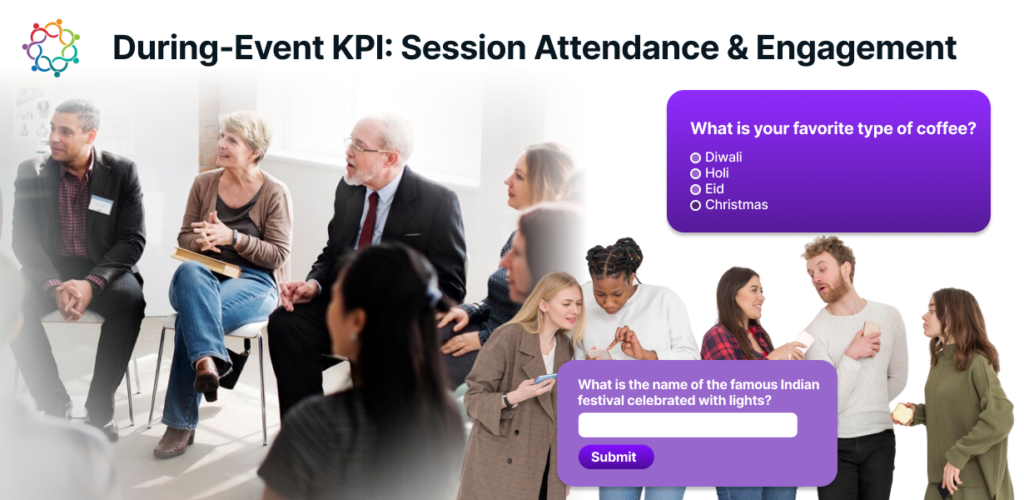
Session attendance rate is the percentage of registered attendees who participate in a particular session. Engagement metrics can include Q&A participation, polling results, and audience interaction during presentations.
Both session attendance and engagement metrics reveal how well your content resonates with the attendees and translates into a stimulating and interactive learning experience.
Strategies to Boost Session Engagement
The key to maximizing session engagement lies in creating a dynamic and interactive learning environment. Here are some strategies to ignite attendee participation:
How Session Data Leads to Content Optimization
Analyzing the session attendance and engagement data provides invaluable insights for future events:
C. Post-Event KPIs
Post-event KPIs offer a retrospective look at your event’s impact and the attendees’ sentiment. These metrics delve beyond simple attendance numbers to reveal the true value your event generated.
5. Attendee Satisfaction
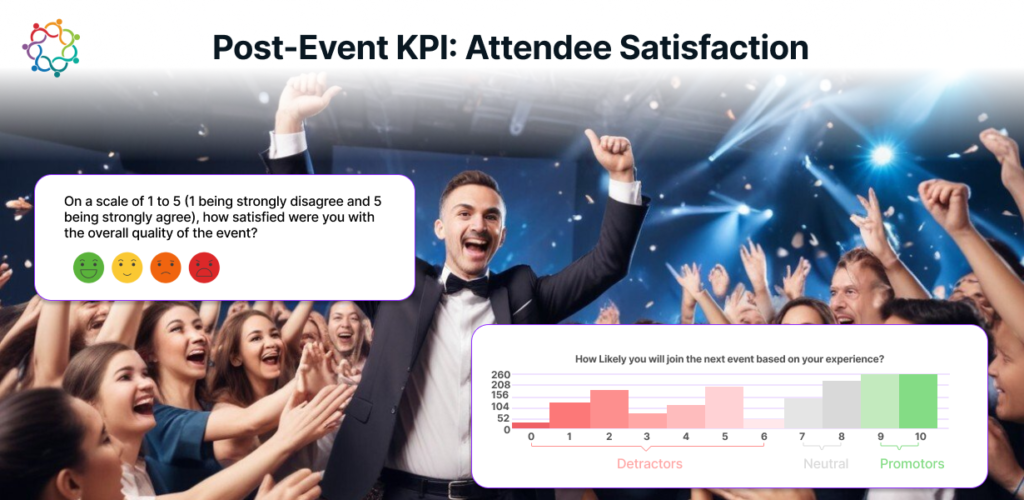
Attendee satisfaction reflects how well you delivered on your promises, created a valuable experience, and nurtured lasting connections with your audience. Measuring the attendee satisfaction goes beyond vanity metrics. It provides invaluable insights that empower you to:
Methods to Capture Feedback
There are several effective methods to gauge attendee satisfaction and gather valuable feedback:
Importance of Feedback Analysis
Analyzing attendee feedback allows you to identify aspects of the event that exceeded expectations and areas that fell short. This feedback serves as a roadmap for refining future events:
How Feedback Assists Event Personalization
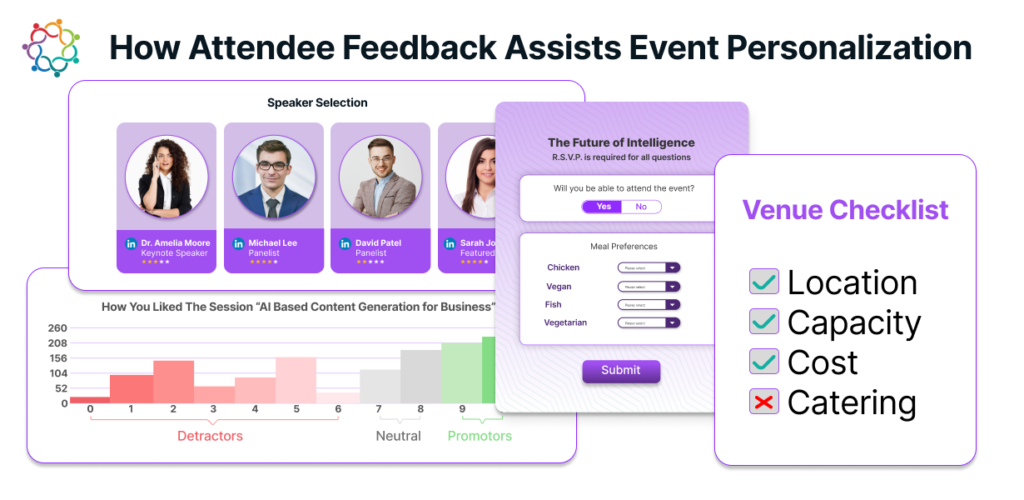
Utilize the attendee feedback to personalize future event experiences and create a more engaging and satisfying experience.
IV. Tools and Resources for Tracking KPIs
The good news is that you don’t have to become a data scientist to track KPIs. Several event management platforms and analytics tools simplify the process. Popular options include Samaaro, Eventbrite Analytics, Cvent, and Bizzabo. These platforms offer features like automated reporting, data visualization tools, and dashboards that make KPI tracking and analysis child’s play.
For budget-conscious event organizers, there are several free or low-cost alternatives. Google Analytics provides valuable website traffic and engagement data, while tools like SurveyMonkey and Typeform can be used to gather attendee feedback through surveys.
V. Conclusion
By embracing KPIs, you can transform your events from one-time occurrences into data-driven success stories. Ready to transform your event optimization journey? Subscribe to our newsletter for more insightful event planning tips and downloadable resources on topics like KPI tracking. Book a demo and start your free trial of Samaaro’s platform to see how data can power your events.
Strategic partnerships can significantly enhance the impact and success of your events. By collaborating with complementary brands, you can expand your reach, tap into new audiences, and create more engaging and memorable experiences. This blog post will guide you through the essential steps to identify and build successful partnerships for your events.

Identifying and selecting compatible brands will let you expand your reach, create more engaging experiences, and achieve your event goals. This section will guide you through the essential steps of identifying the right partners for your event.
To identify the right partners, start by clearly understanding your target audience’s demographics, interests, and needs. This will help you tailor your event to their preferences and attract the most relevant attendees. Next, define your event goals. Are you aiming to increase brand awareness, generate leads, build relationships, or something else? Your goals will guide your partner selection and collaboration strategies.
Identify brands that operate in the same or complementary industries as yours. This will increase the relevance and appeal of the partnership to your target audience. Look for brands that share similar values and mission statements, ensuring a harmonious and productive partnership. Additionally, consider brands that offer complementary products or services to create a more comprehensive and valuable experience for the attendees.
When evaluating potential partners, assess their past collaborations, customer feedback, industry recognition, and online reputation. Look for evidence of successful partnerships, positive reviews, awards, and a strong online presence. This information will help you identify partners that align with your brand and can deliver valuable collaborations.
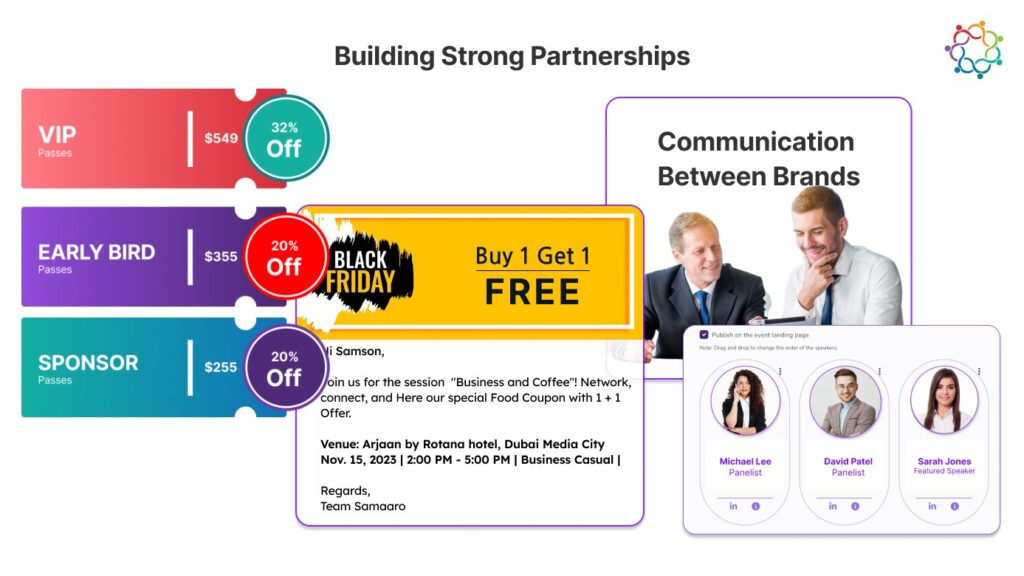
Building strong partnerships with complementary brands allows you to expand your reach, tap into new audiences, and create more engaging and memorable experiences. This section will explore key strategies for building effective partnerships and creating long-term relationships.
To build strong partnerships, it’s essential to establish open and honest communication channels, actively listen to your partners’ needs and concerns, and negotiate in a collaborative and mutually beneficial manner. By generating trust, understanding, and a shared commitment to achieving your goals, you can create lasting partnerships that drive success.
Leverage complementary strengths to create a more powerful impact. Develop a clear understanding of how the partnership will benefit both parties. Ensure that the collaboration aligns with each partner’s strategic objectives and provides value to your target audience.
Utilize the resources and expertise of your partners to enhance your event. For example, collaborate on marketing and promotion by creating joint campaigns and sharing resources. Additionally, invite guest speakers from your partner organizations to share their expertise and insights with attendees. Furthermore, offer exclusive discounts or promotions to attendees who register through your partner’s channels. Finally, cross-promote each other’s events on your respective platforms to reach a wider audience.
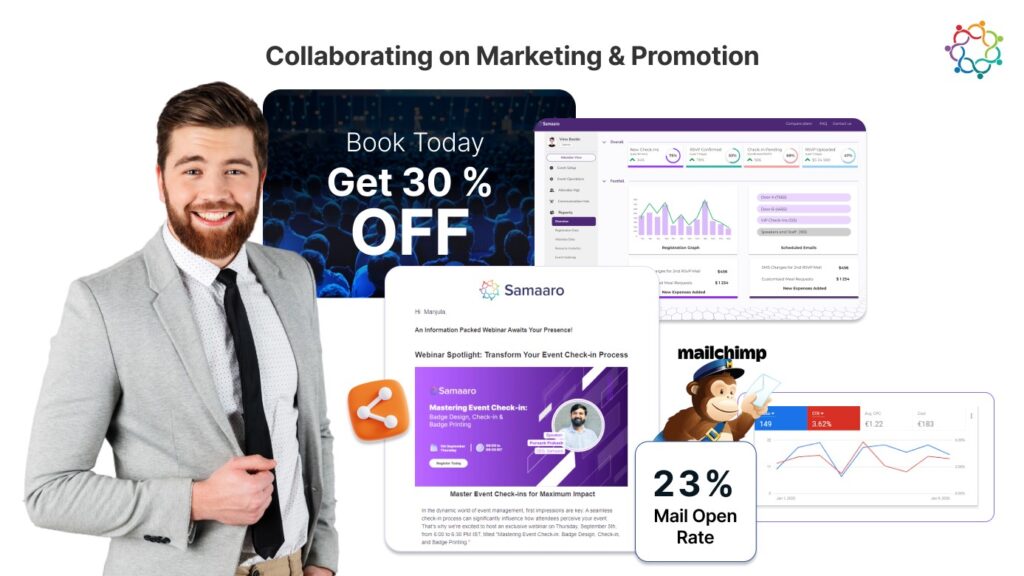
Effectively combining your marketing efforts and resources lets you create more powerful campaigns and reach a wider audience. This section will explore strategies for collaborating on marketing and promotion, including joint campaigns, cross-promotion, and resource sharing.
To maximize your reach and engagement, consider developing joint marketing campaigns with your partner brands. This could involve creating co-branded social media content, shared email marketing campaigns, cross-promotion on websites and newsletters, and joint press releases. By combining your efforts, you can reach a wider audience, generate more interest, and increase the overall impact of your event.
Encourage partners to actively promote the event on their social media platforms, such as Facebook, Twitter, LinkedIn, and Instagram and other channels, such as websites and newsletters. Use relevant hashtags, engage with your audience, and share compelling content to generate excitement and drive registrations.
Collaborating on content creation, sharing best practices, and providing valuable insights can enhance the overall value of your event for the attendees. This could involve sharing industry insights and expertise with the attendees through presentations or panel discussions and collaborating on thought leadership pieces to position yourselves as industry experts.

By working together with complementary brands, you can leverage each partner’s unique strengths, resources, and expertise to develop innovative and memorable events. This section will explore strategies for co-creating engaging event experiences that resonate with your target audience and drive positive outcomes.
To create engaging content and activities that resonate with both your brand and your partner’s audience, identify shared interests and topics, collaborate on workshops or panel discussions, and organize networking opportunities. By working together, you can develop a diverse and engaging program that offers value to attendees from both brands.
When selecting speakers, look for individuals with expertise in areas that are relevant to both brands and your target audience. Develop a balanced program that includes a mix of keynote speeches, panel discussions, workshops, and networking opportunities. Ensure that the speakers you choose align with the overall theme and objectives of your event.
To create a truly exceptional event experience, focus on developing a distinctive theme or concept that reflects the partnership and sets your event apart from competitors. Incorporate interactive elements, such as workshops, demos, or games, to engage attendees and make the event more memorable. Allow attendees to personalize their experience by offering choices or customization options, such as selecting specific sessions or workshops. Finally, create a strong visual identity for your event that reflects the partnership and creates a lasting impression.
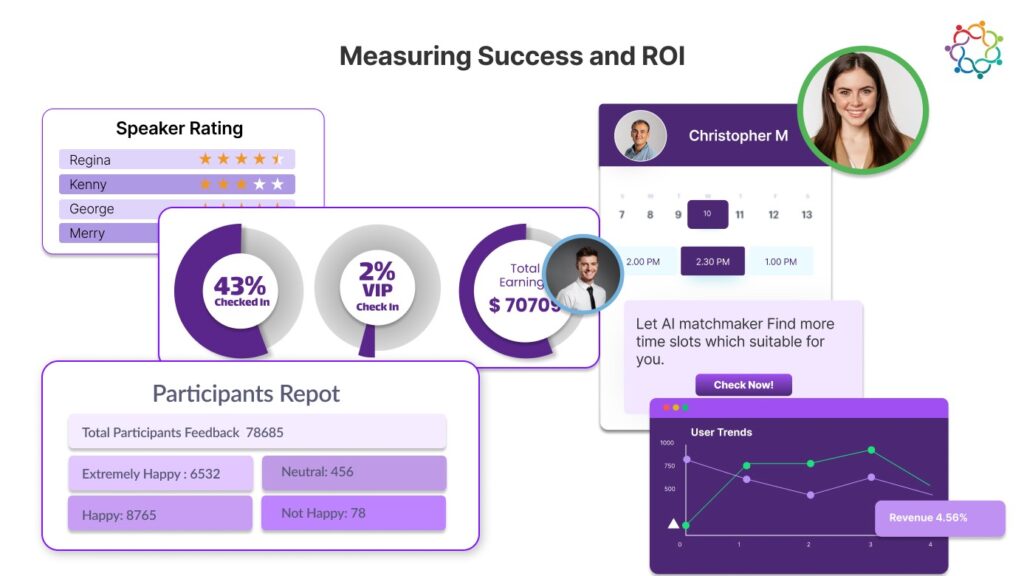
To effectively evaluate the impact of your brand collaborations and ensure they align with your overall business goals, it’s essential to track and analyze key performance indicators (KPIs). By measuring success and return on investment (ROI), you can gain valuable insights into the effectiveness of your partnerships and make data-driven decisions for future collaborations.
Monitor key metrics such as event attendance, lead generation, customer satisfaction, social media engagement, and website traffic to gain a comprehensive understanding of your partnership’s effectiveness. By tracking these metrics, you can identify trends, measure the impact of your partnership on key business objectives, and make data-driven decisions for future collaborations.
Compare event performance with and without partnerships to assess the impact of collaboration on key metrics. Follow this by evaluating brand exposure by measuring the increase in brand awareness and recognition. Then, analyze customer feedback to understand how the partnership enhanced the attendee experience. Finally, calculate ROI by considering factors such as increased revenue, cost savings, and brand exposure.
To calculate ROI, divide the net profit from the partnership by the total cost of the partnership. Consider factors such as increased revenue, cost savings, brand exposure, and customer acquisition costs when calculating the net profit.
Conclusion
By following these steps and building strong partnerships with complementary brands, you can significantly enhance the impact and success of your events. Strategic collaborations can help you reach new audiences, create more engaging experiences, and drive business growth. Remember to focus on building mutually beneficial relationships, effective communication, and collaboration on all aspects of your event planning.
Book a demo or start your free trial of Samaaro’s platform today to see how we can help you elevate your event strategy!
Do you ever feel like your event website is a beautiful, lonely island in the vast digital sea? You’ve poured your heart into crafting the perfect event, but the website visitor numbers just don’t translate into registrations. This scenario is all too common for event organizers. The good news is it doesn’t have to be this way.
Converting website visitors into event registrants is all about website optimization. Think of it as the bridge connecting website traffic to a thriving event. By implementing strategic website optimization techniques, you can dramatically increase the number of attendees and ensure your event is a resounding success. Here, we’ll explore five key strategies to transform your website from a passive brochure into a powerful lead generation machine.
1. Compelling Event Website
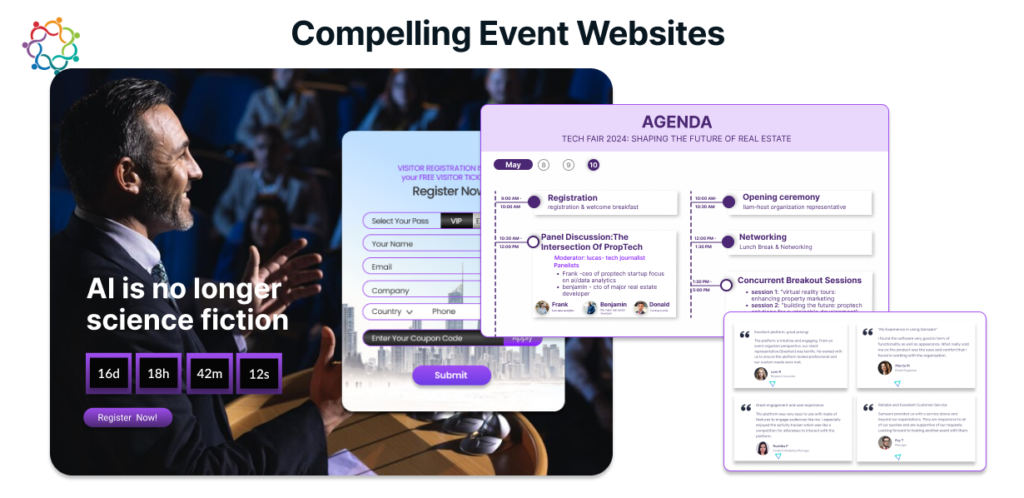
A compelling event website is crucial because it’s your digital first impression and conversion machine. It attracts visitors, informs them clearly, and convinces them to register with enticing visuals, seamless registration, and trust-building elements like testimonials. Without a strong website, your event might be a well-kept secret, missing out on potential attendees.
First Impressions:
When someone lands on your event website, it’s like walking into your event for the first time. Just like a well-decorated venue sets the tone, a visually appealing and user-friendly website design is crucial. Picture crisp, high-resolution images showcasing the event experience, clear and concise event information readily accessible to visitors, and an intuitive navigation system that guides them effortlessly towards registration.
Clarity:
Highlight essential details like date, time, location, and a comprehensive event agenda. Don’t underestimate the power of compelling visuals. Images and videos can paint a thousand words, showcasing the energy and excitement attendees can expect.
Website Layout:
Think of your website layout as a map leading the visitors directly to the registration page. It’s important to streamline the registration process, minimizing unnecessary steps and forms. The visitors shouldn’t feel like they’re navigating a maze. In addition, utilize clear call-to-action (CTA) buttons with action verbs like “Register Now” or “Get Your Tickets.”
Social Proof:
The power of social proof cannot be ignored. So, feature testimonials from past attendees, showcase quotes from renowned speakers, and include engaging speaker bios. These elements build trust and credibility, convincing the visitors that your event is worth attending.
2. Clutter-Free Landing Pages
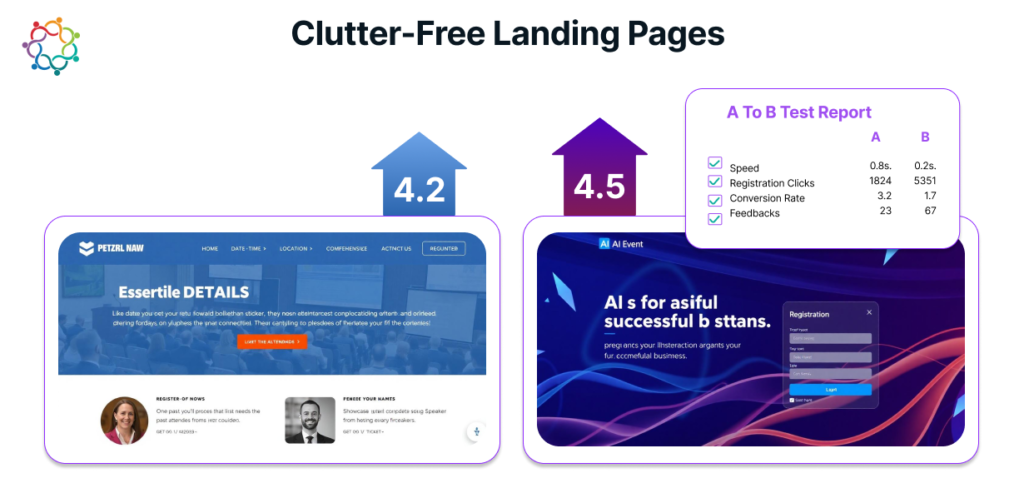
Landing pages are dedicated web pages designed with a singular purpose: capturing registrations. Unlike your main event website, landing pages offer a laser-focused message tailored to specific marketing campaigns or visitor demographics. This targeted approach allows you to deliver highly relevant content and compelling CTAs, in turn maximizing conversion rates.
How to Optimize Landing pages for Conversions
In the fast-paced world of event marketing, every click counts. But how do you turn those website visitors who land on your event page into registered attendees? Let’s dive into the secrets of landing page optimization:
Minimize Distractions:
Landing pages are not the place for navigation menus or additional links. Think of them as a one-way street leading to registration. Therefore, maintain a clean, clutter-free design that guides the visitors effortlessly towards the call to action (CTA) button.
Embrace A/B Testing:
Don’t be afraid to experiment with different landing page elements, such as headlines, call-to-action buttons, and visuals. By comparing different variations, you can identify the most effective combination that drives the highest conversion rates.
Craft Compelling Headlines:
To make a great first impression, craft captivating headlines that grab attention and clearly communicate the benefits of attending your event. Don’t be afraid to be bold and specific. Next, deliver a crystal-clear value proposition. Provide answers to questions such as what problem your event solves and how it will benefit the attendees. Articulate the unique value attendees will gain by registering – knowledge, connections, experiences – that make your event stand out.
3. Content Marketing
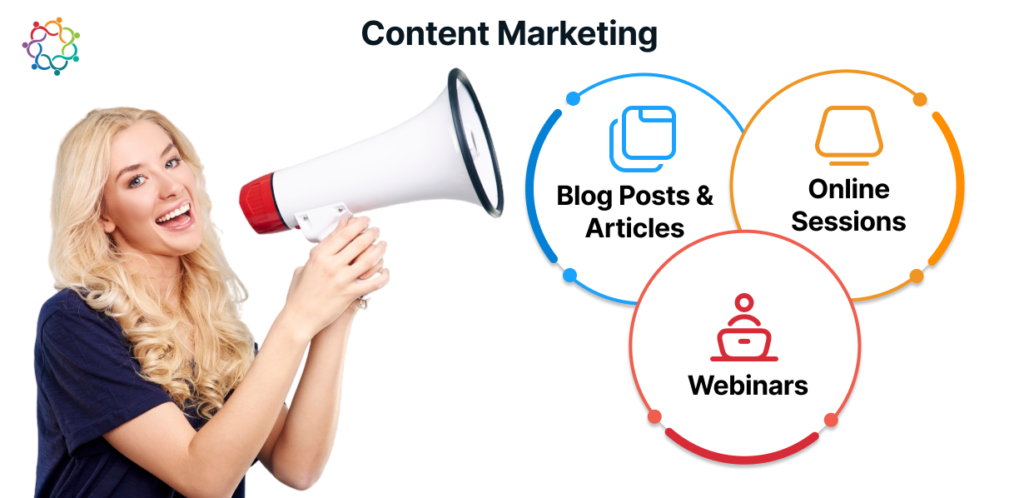
In the digital age, content is king, and event marketing is no exception. Valuable, informative content not only attracts website visitors but also positions you as a thought leader in your industry. This powerful combination is what propels your event towards success.
What Types of Content You Should Publish
Content reigns supreme, but with so many options available today, where do you begin? When it comes to event promotion, the right content mix can be the key to attracting a captive audience and driving registrations. Let’s explore the various content formats:
Blog Posts & Articles:
Consider creating blog posts and articles related to your event theme. These act as magnets, drawing in potential attendees interested in the topics your event explores. Moreover, discuss industry trends, offer expert insights, or dive into specific challenges your event aims to address. By providing valuable content, you establish yourself as a trusted resource, increasing brand awareness and piquing visitor interest in your event.
Webinars & Online Sessions:
Webinars and online sessions are powerful tools to take your content marketing a step further. Hosting pre-event webinars or online sessions allows you to showcase your expertise, go deeper into event themes, and generate excitement for the main event. It is a great opportunity to offer valuable content in exchange for registration and capture valuable leads who are highly interested in the topics your event covers.
How to Promote Your Content & Drive Traffic
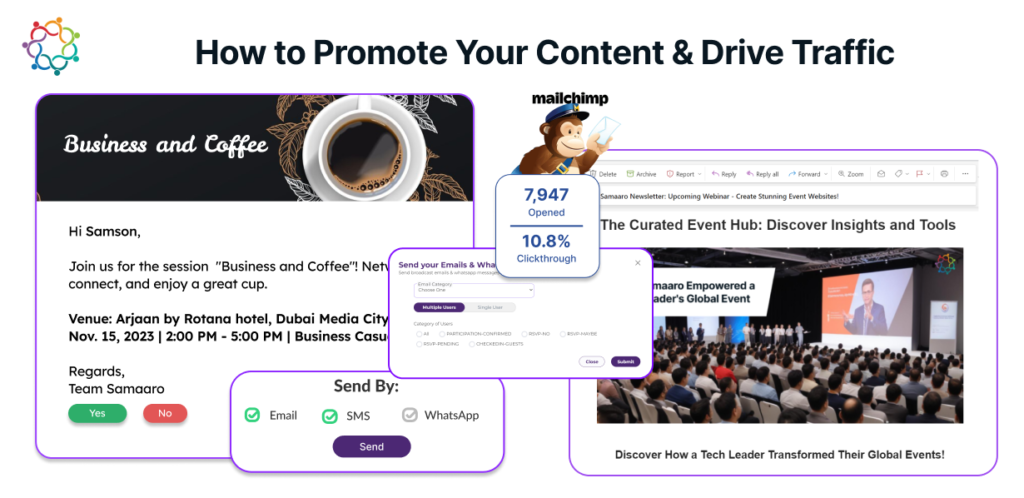
No matter how exceptional your content is, even the most informative blog post or engaging webinar can get lost in the content clutter. To maximize the impact of your content, you need a strategic promotion plan:
SEO:
Optimize your content with search engine optimization (SEO) best practices. This ensures your content appears higher in the search engine results pages, making it more discoverable by potential attendees actively searching for topics related to your event. The more organic traffic you attract, the more website visitors you can convert into registrants.
Social Media:
Don’t let your content languish in the shadows. Utilize social media platforms and email marketing campaigns to strategically promote your content. Share engaging snippets of your blog posts, highlight upcoming webinars, and offer downloadable content related to your event. These efforts drive qualified traffic back to your event website, ultimately converting website visitors into enthusiastic registrants.
By consistently creating high-quality content, you establish yourself as a thought leader in your industry. This builds trust and credibility with potential attendees, making them more likely to register for your event, knowing they’ll gain valuable knowledge and insights from the experience.
4. Lead Capture Strategies
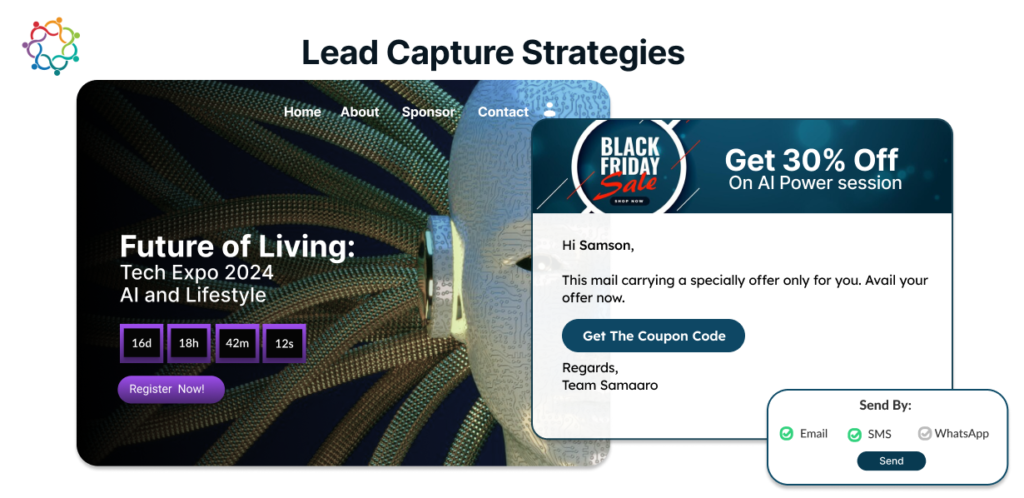
Your event website is abuzz with visitors, but how do you convert that curiosity into registrations? Here’s your answer:
Lead capture forms:
Lead capture forms are the gateway to building your event’s attendee base by transforming website visitors into potential attendees. That’s why it becomes vital to offer valuable downloadable content, like industry white papers or comprehensive event guides, in exchange for email addresses. This provides valuable resources for the potential attendees while giving you the opportunity to nurture leads and ultimately drive registrations.
Pop-ups:
Pop-ups can be an effective tool if used strategically. A well-timed pop-up appearing as a visitor delves deeper into your event details could offer a relevant discount code for early registration or exclusive content related to a specific session. Besides, targeted pop-ups can capture the visitors’ attention and nudge them towards registration, but remember, the key is to avoid being intrusive or creating a negative user experience.
5. Email Marketing
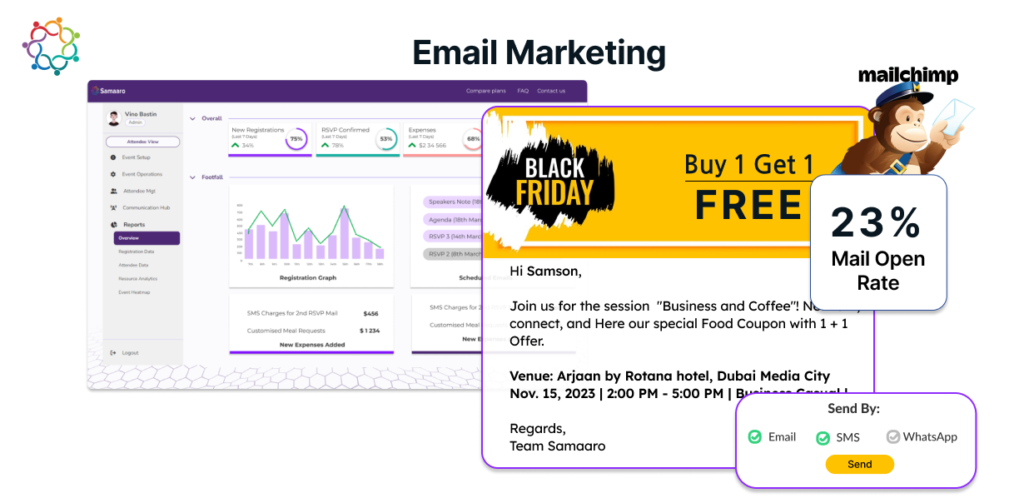
Once you’ve captured those valuable email addresses, it’s time to leverage the power of email marketing. Effective email campaigns are the secret weapon; however, generic blasts won’t cut it. The key lies in crafting targeted emails that resonate with different audience segments.
Segment your email lists based on visitor interests and their stage in the buying journey. For example, someone who just discovered your event might be in the “awareness” stage. Send them an introductory email highlighting the event’s theme and key benefits. Whereas, for visitors who downloaded an event guide (indicating deeper interest), they might be in the “consideration” stage. Send them a targeted email showcasing speaker insights or a specific session relevant to their downloaded content. Finally, for those who haven’t registered yet but have interacted with your website multiple times, they might be nearing the “decision” stage. Send them a compelling email with a limited-time discount or a reminder about the registration deadline.
Don’t spend hours crafting individual emails. Utilize email automation tools to streamline campaign management. These tools allow you to schedule automated email sequences based on visitor behavior and engagement, saving you time and ensuring timely communication.
No matter the email’s purpose, always include clear and compelling calls to action (CTAs). Whether it’s a button prompting them to “Register Now” or a link to learn more about a specific speaker, CTAs guide the visitors towards the desired action, which is, registering for your event.
As the event date approaches, send timely reminder emails. These can highlight the excitement building around the event, showcase the agenda once again, or offer logistical details like venue access information.
Actionable Steps
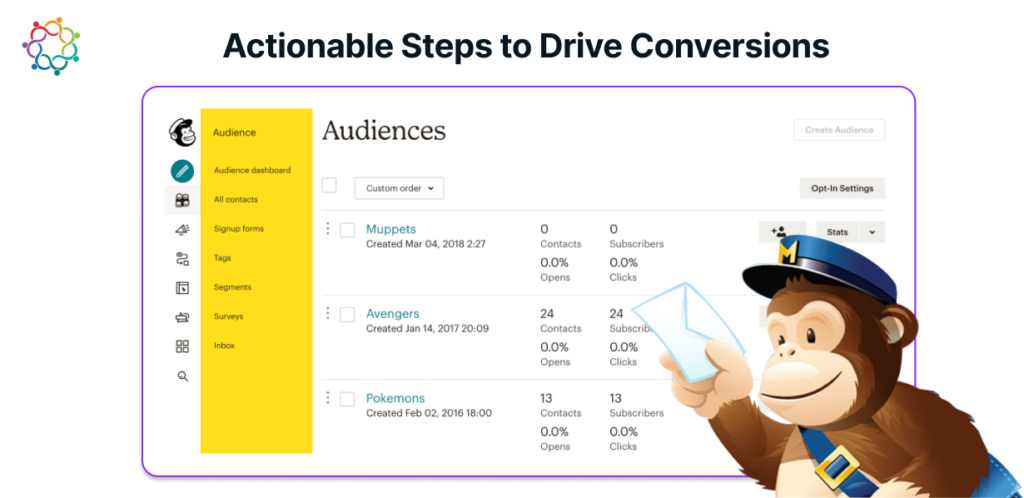
Now that you’ve explored the key strategies for landing page optimization, it’s time for you to act. Here are some practical steps to get you started:
Traffic Analysis:
Not all website visits translate to registrations. Utilize analytics tools to pinpoint where visitors are dropping off in the conversion funnel. Are they leaving the homepage without exploring further? Are they abandoning the registration form halfway through? By identifying these bottlenecks, you can refine your website and landing pages to address the visitors’ pain points and smoothen the path towards registration.
A/B Testing:
Test different headlines, CTAs, and even visual elements like images or videos. In the meantime, track the results and see which combination resonates best with your audience. This ongoing experimentation ensures your landing pages continuously adapt, improve, and drive high conversion rates.
Website Analytics:
Leverage website analytics tools like Google Analytics to gain invaluable insights into the visitors’ behavior. Track key metrics like bounce rate (percentage of visitors leaving after just one page), conversion rates (percentage of visitors who complete the desired action, in this case, registration), and time spent on pages. By analyzing this data, you can identify areas for improvement. For example, a high bounce rate on your landing page might indicate confusing navigation or a lack of clarity in the value your event provides.
Conclusion
Remember, website optimization is an ongoing process. Continuously monitor your results, adapt your approach, and refine your strategies to maximize website conversions and ensure your events are a resounding success.
Ready to take your event marketing to the next level? Subscribe to our newsletter for actionable tips and best practices on how to optimize your website and turn website visitors into enthusiastic event registrants. Simply enter your email address to get started!
Juggling spreadsheets, sending countless emails, and chasing down RSVPs can quickly drain the excitement out of planning your next event. But what if there was a way to streamline tasks, boost engagement, and generate valuable leads – all while saving you precious time? Samaaro’s event marketing automation offers a powerful solution, transforming the event from a logistical headache into a strategic opportunity for success. Before we dive into the features that make this possible, let’s understand why we need automated marketing in the first place.
Challenges of Non-Automated Event Marketing
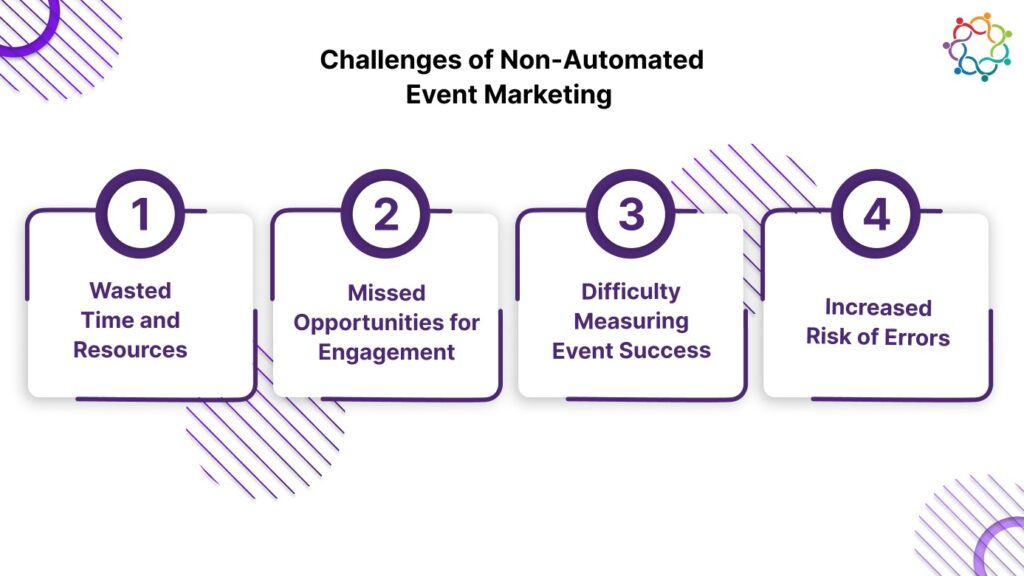
Marketing automation for events isn’t just about efficiency; it plays a critical role in gauging the success of your events. Here’s why relying solely on manual processes makes measuring results a challenging task:
Every aspect of the event lifecycle, from sending invites to managing registrations and following up with leads, is done manually. This consumes a significant amount of time and diverts resources away from strategic activities for your marketing team.
Without automation, real-time data on attendee behavior and marketing campaign performance is unavailable. The crucial step of developing valuable connections gets neglected, resulting in a negative brand experience.
Understanding the complete attendee journey is crucial for measuring the ROI of your event marketing efforts. But it becomes challenging to track the attendees’ path and quantify the event’s success without proper data and analytics.
Manual data entry and repetitive tasks are prone to errors. Typos in emails, inaccurate registration information, or missed follow-ups can hurt your professional image and impact lead nurturing efforts.
3 Ways Samaaro’s Event Marketing Automation Nurtures Leads
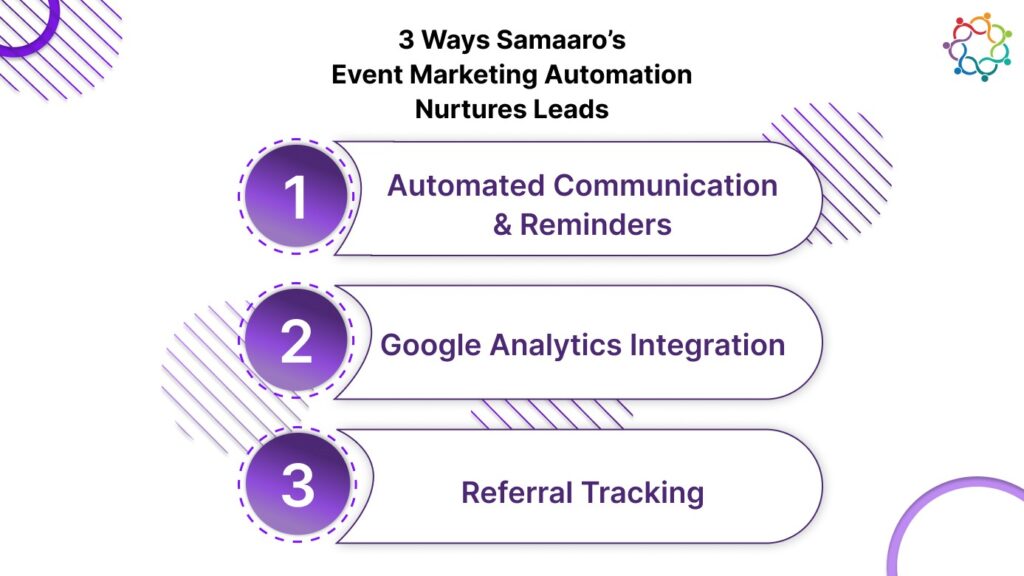
From automated emails and reminders to seamless Google Analytics integration and insightful referral tracking, Samaaro’s marketing automation for events empowers you to manage the entire event lifecycle efficiently. Read on to know more about these features:
Automated email sequences triggered from Samaaro’s registration software ensure you never miss a beat, making it easier to send targeted invitations, confirmations, and personalized thank-you messages at the perfect moments. It lets you send timely emails to keep the leads informed about important deadlines, pre-event logistics, and session details. Additionally, our RSVP solutions allow you to send automated reminders to those who haven’t RSVP’d yet, ensuring you have an accurate headcount.
Benefits–
Samaaro’s registration software doesn’t just automate tasks, it creates a more efficient and engaging environment for everyone involved. It empowers you to entice hesitating attendees to attend your event by automating strategic pre-event communication campaigns like sending valuable content and promoting the big names.
2. Google Analytics Integration:
Marketing automation also includes gaining deeper insights. Samaaro integrates with Google Analytics to provide valuable insights into your audience’s behavior and the effectiveness of your pre-event marketing efforts. It helps you track key metrics like website traffic, user behavior, and referral sources for the event registration pages or landing pages.
Benefits–
These key metrics in conjunction with the data from Samaaro’s event registration software provide a holistic view of your marketing efforts and understand which marketing channels are driving the most valuable leads.
3. Referral Tracking:
For each marketing channel, be it email campaigns or partner websites, Samaaro generates unique UTM codes. These codes are seamlessly embedded into promotional links and emails. When someone clicks on a referral link, the UTM code gets attached to their browser activity. This is how Samaaro tracks the source of the referral.
Benefits–
Referral Tracking allows you to track which channels and partners drive the most registrations, empowering you to focus your marketing efforts on high-performing sources. This data also reveals which channels generate the most qualified leads, allowing you to allocate your marketing budget strategically and strengthen valuable relationships.
Benefits of Samaaro’s Event Marketing Automation
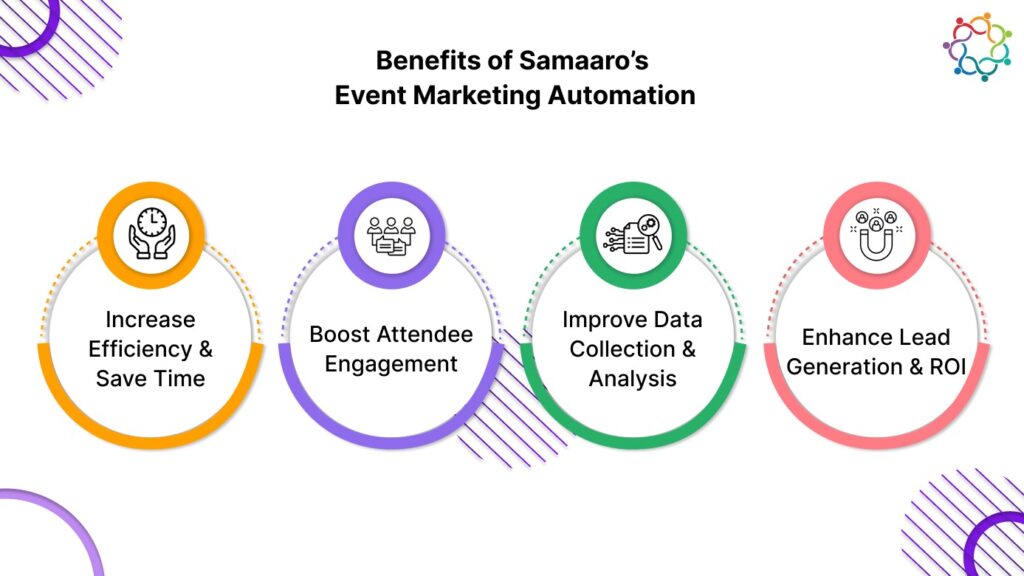
Samaaro’s marketing automation for events can unlock a treasure trove of valuable data, empowering you to move beyond guesswork and make strategic decisions based on attendee behavior. Read on to understand its benefits in detail:
Samaaro’s event registration software makes it possible to manage all aspects of the event lifecycle – from sending invitations to tracking RSVPs and generating leads – within a single, intuitive interface. More importantly, it automates repetitive tasks so your team can focus on strategic initiatives like crafting compelling content, creating personalized outreach campaigns, and analyzing data for actionable insights.
Automated email sequences allow you to keep the attendees informed before the event and generate excitement for the event experience. On receiving emails relevant to their interests, attendees are more likely to open, read, and click through to additional information. This translates to higher engagement with pre-event content and ultimately, with the event itself.
Samaaro’s integration with several tools helps you gain deeper insights into how attendees interact with your pre-event communication, the event itself, and post-event content. This knowledge allows you to optimize the attendee journey for future events.
Our registration software provides past data, helping you understand which audience demographics yielded the highest-quality leads. Use this knowledge to refine your marketing efforts and target similar profiles for future events. Leveraging our reports on engagement metrics can help you assess the quality of your leads and refine your marketing strategy, in turn maximizing your return on investment.
Conclusion
By personalizing communication, targeting high-value leads, and leveraging powerful analytics, you can unlock the true potential of your events and achieve a significant return on investment. Book a demo or start your free trial with Samaaro today and start automating your events for maximum ROI.
Effective budget management is the most important component of event planning, despite the fact that it entails an abundance of intricate duties. Mockups for community festivals, corporate summits, charity galas, and every other event all rely heavily on meticulous budget planning and management to ensure their success and seamless execution.
The Significance of Efficient Budget Management for Events
Irrespective of their size or objective, all events require financial expertise. A budget that is meticulously managed and organized functions as a financial guide, providing organizers with direction regarding the numerous decisions and expenditures. Effective budgeting serves as more than just a financial reconciliation process; it functions as a strategic instrument that facilitates the allocation of resources, supports decision-making, and protects against possible financial risks.
Impact of Event Success
The implications of effective budget management permeate all aspects of an occasion. These elements comprise the quality of services rendered, the experiences of attendees, the appeal of the event to potential sponsors, and ultimately determine its success or lack thereof.
A well-designed budget not only prevents excessive spending but also enables event coordinators to maximize resources, secure more favorable agreements, cultivate collaborations, and execute a smooth event experience while adhering to pre-established financial constraints.
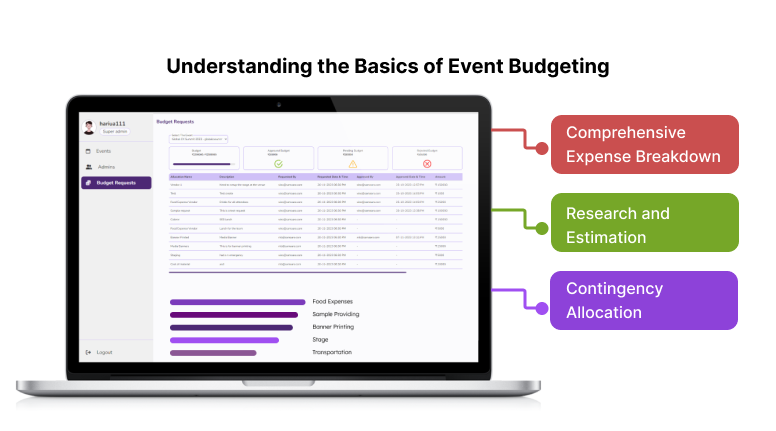
Prior to discussing budget management tips, it is essential to have a firm grasp of the fundamentals of event budgeting. This consists of:

Creating a Detailed Budget Strategy
The establishment of an elaborate budget plan serves as the foundation of effective event budget management. The process entails the division of expenditures into distinct categories, the estimation of costs, and the allocation of contingency funds.
The process of classifying expenses is essential in order to maintain clarity and organization. Venue, marketing/promotion, catering, staffing, equipment rentals, permits/licenses, decorations, and miscellaneous expenses are typical categories. The budget should be divided into categories according to their respective importance and anticipated costs.
Conduct extensive research to collect quotations and estimates for every category. For competitive pricing, consider historical data from previous events, conduct market research, and contact multiple vendors. Incorporate all potential expenditures, even those that may appear insignificant, in order to prevent budgetary overruns.
Typically, 10% of the entire event budget should be set aside as a contingency fund. This serves as an emergency fund to provide coverage for unanticipated costs or complications that may occur throughout the event’s planning or implementation stage. It is crucial to maintain a contingency fund balance and only use it when absolutely required.
Negotiation and Strategies for Cost Reduction
The implementation of successful negotiation strategies and cost reduction techniques can have a substantial influence on the overall budget of an event while maintaining its high standard of quality.
To secure better agreements with suppliers and vendors, develop your negotiation skills. Conduct price comparisons, consult about package deals, seek discounts, or negotiate for additional services while adhering to the allocated budget. Developing positive relationships with suppliers can frequently result in reduced costs or additional benefits.
Investigate a range of cost-saving alternatives to ensure quality is not compromised. One example of cost-effective promotion strategies is to explore alternative venue options, select a catering package that is more economical, or utilize digital marketing. Maintain a receptive mindset and contemplate innovative resolutions that are in accordance with the objectives of the occasion.
To minimize expenses, pursue sponsorships or partnerships. Form partnerships with pertinent enterprises or institutions that share a common vision or objective with the occasion. Offer sponsors esteemed visibility in exchange for monetary or non-monetary contributions.
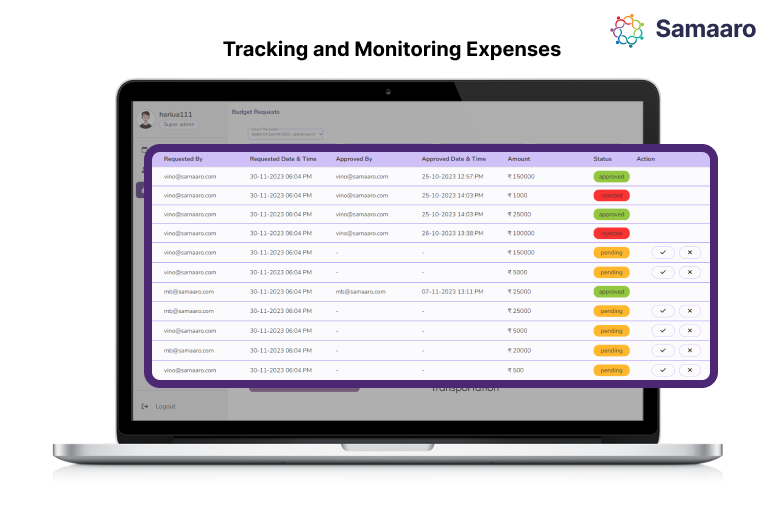
Monitoring and Keeping Track of Expenses
Efficient expense tracking and monitoring guarantees adherence to the designated budget for the event and facilitates any required modifications.
Make use of specialized software or budgeting tools that facilitate the monitoring and management of expenses. These tools are capable of generating reports, automating processes, and providing real-time insights into expenditure patterns.
Selecting tools that align with the magnitude and intricacy of the event, while also being intuitive for the coordinating staff.
Review and revise the budget on a regular basis during the planning phase. Consistently verify expenditures in relation to the budget in order to detect any potential deviations or opportunities for adjustments.
Facilitate regular team meetings to ensure that all members are in agreement with the financial objectives and to discuss budget updates.
Making Contingency Plans
It is critical to be well-prepared for unanticipated events to manage unanticipated costs without compromising the success of the occasion.
One should proactively anticipate potential challenges or emergencies that may occur and designate a buffer within the budget to effectively manage these matters.
It is advisable to remain informed about industry developments and external factors that may have an influence on the financial aspects of the event.
Be Aware of the Frequent Occurrence of Last-Minute Modifications or Supplements in the Field of Event Coordination. Allocate funds in the budget to facilitate these modifications so as to prevent substantial financial hardship.
Maintain effective channels of communication with vendors and team members in order to promptly adjust to any required modifications.
Construct contingency plans to safeguard pivotal elements of the occasion that could be impacted by financial excesses or unforeseen circumstances. Possible actions include identifying alternative vendors or, if necessary, reducing the scale of specific components.

Post-Event Analysis and Evaluation
After the event, conducting a thorough evaluation yields valuable insights that can inform future budgetary decisions and enhancements.
Conduct a comparison between the budgeted and actual expenditures. Determine where the budget performed admirably and where deviations occurred or unanticipated expenses arose.
Assess the event’s comprehensive success with respect to return on investment, contentment of attendees, and fulfilment of organizational goals.
Implement the results of the evaluation to discern effective cost-reduction tactics as well as areas that require enhancement for subsequent events. Document the insights gained from these teachings and modify or adjust budgeting strategies accordingly.
Through the implementation of these comprehensive strategies for efficient budget management, event organizers can successfully navigate financial obstacles and guarantee a memorable and triumphant event experience while adhering to the allotted resources.
In conclusion, dynamic and vital to the event planning process is the administration of the budget for an effective event. Through the implementation of a thorough budget plan, strategic cost-cutting and negotiation techniques, meticulous expense tracking, prepared for unforeseen circumstances, and post-event evaluations, event organizers can guarantee not only the monetary triumph but also the holistic efficacy and influence of the event. By memorizing these guidelines, event organizers will be able to effectively manage financial constraints while producing outstanding events.
Remember, successful budget management isn’t just about numbers; it’s about strategic planning, flexibility, and adaptability to ensure a memorable and impactful event within the allocated financial resources.
Events provide invaluable prospects for networking, the exchange of knowledge, and the building of significant connections. Nevertheless, in an era brimming with diversions, effectively involving participants in these events can present a substantial obstacle. To optimize the outcomes of an occasion, organizers must give priority to engagement strategies throughout its three phases: pre-event, during the event, and post-event. This all-encompassing manual reveals successful event engagement strategies customized for every stage, enabling event organizers to craft indelible moments for participants.
Utilizing Social Media Platforms
By leveraging social media platforms, one can effectively generate excitement and interest prior to an upcoming event. Complement audience participation by generating interactive content in addition to disseminating previews. It is advisable to incorporate user-generated content and polls pertaining to event subjects, while also promoting discussions through the use of event-specific hashtags. By involving the audience in discussions weeks prior to the occasion, one can foster a sense of community that is insatiably excited for the assembly.
Implementing Teaser Campaigns and Countdowns
Foster collaboration with event speakers or partners to augment teaser campaigns. Share brief video excerpts featuring speakers elaborating on their sessions or collaborators describing their contributions. Employ countdowns in a strategic manner, integrating them with exclusive announcements or sneak glimpses, to cultivate increased anticipation as the occasion draws near.
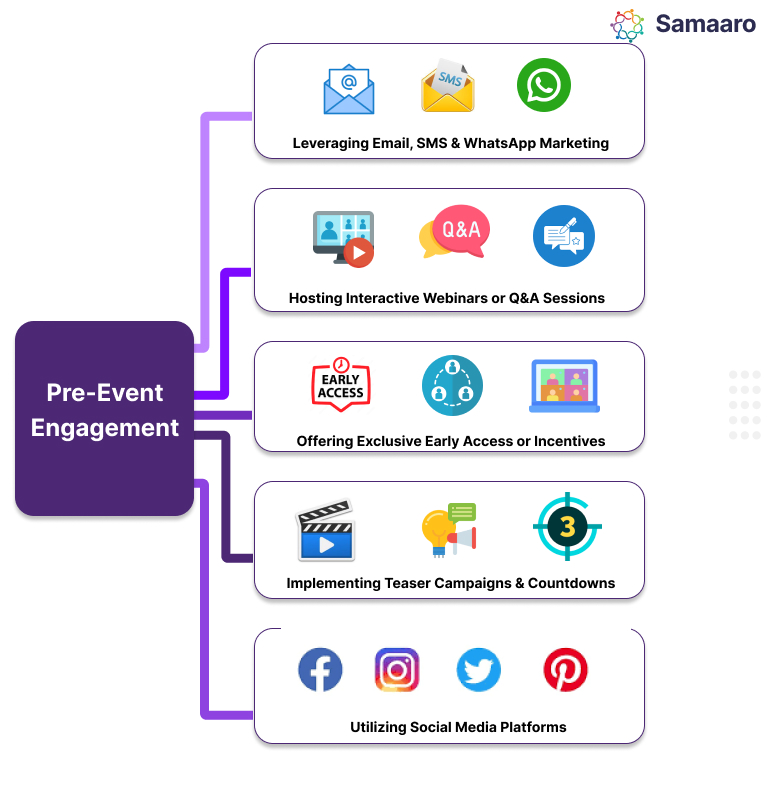
Offering Exclusive Early Access or Incentives
To stimulate early registrations, consider granting attendees early access to keynote addresses, seminars with limited seating, or exclusive networking opportunities. Promote a sense of exclusivity and value among early registrants by providing them with exclusive event packages, digital resources, or reduced-price access to partner products.
Hosting Interactive Webinars or Q&A Sessions
To optimize engagement prior to an event, organize thought-provoking and interactive webinars or panel discussions featuring prominent lecturers. Promote engagement among attendees by providing them with the opportunity to pre-submit inquiries or suggestions for topics. Advocate for the broadcast of these sessions through diverse platforms and contemplate the option of providing on-demand access for individuals unable to attend in person.
Leveraging Email, SMS & WhatsApp Marketing
By utilizing email marketing, one can not only disseminate event details but also highlight speaker profiles, session agendas, and sneak views of event venues through email campaigns. Integrate interactive components such as RSVP buttons, interactive maps, or personalized agendas into email correspondence to optimize the attendee experience and sustain their interest.
Creating Interactive Sessions or Workshops
To enhance the engagement of participants, incorporate a variety of session formats such as interactive demonstrations, roundtable discussions, and hands-on seminars. Permit participants to actively participate, share thoughts, and acquire practical knowledge, thereby cultivating a dynamic educational setting.
Encouraging Attendee Participation
During presentations, integrate real-time interaction tools such as live polls, open question and answer sessions, and live discussion forums. Motivate participants to contribute their viewpoints, pose inquiries, and interact with instructors in order to enhance the interactivity and customization of the sessions.
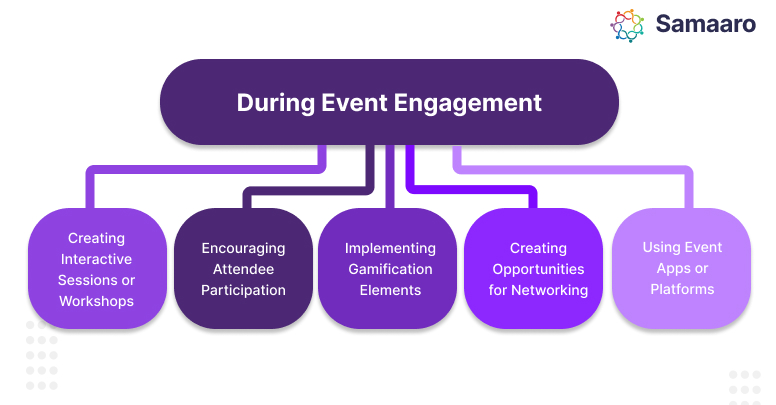
Implementing Gamification Elements
Examine a range of gamification components, such as leaderboards, scavenger quests, and interactive challenges that are tied to session engagement. Incentivize attendees to actively participate throughout the event by offering points that can be redeemed for exclusive benefits or prizes.
Creating Opportunities for Networking
Organize networking sessions that are in line with the interests or sectors of the attendees. It is advisable to incorporate matchmaking algorithms into event applications in order to propose pertinent connections or to facilitate networking sessions that foster substantive exchanges.
Using Event Apps or Platforms
Capitalize on event-specific applications or platforms that empower participants to generate customized timetables, participate in real-time discussions, exchange perspectives, and offer immediate input. Incorporate functionalities such as interactive maps, live polling, and session ratings to augment the overall event experience.
Personalized Thank-You Emails
Construct email follow-ups to the event that convey appreciation, incorporating personalized highlights that align with the individual interests of each attendee. To enhance post-event value, incorporate hyperlinks to pertinent resources, recordings, or supplementary content that was disseminated during the event.
Sharing Event Highlights
Development of an all-encompassing post-event content strategy. Disseminate behind-the-scenes footage, event highlights, keynote excerpts, attendee testimonials, and sneak peeks through newsletters and social media platforms. Curate compelling content formats such as blog summaries, videos, and infographics to increase engagement and reach.

Requesting Feedback
Implement thorough post-event surveys or questionnaires to collect detailed feedback on a multitude of event-related topics, such as programming, networking prospects, operational procedures, and overall participant contentment. Using this feedback as a guide, determine which aspects of future events could be enhanced.
Offering Post-Event Resources
Enable participants to retrieve session recordings, presentation slides, whitepapers, and other resources that were disseminated throughout the event at their convenience. Provide attendees with a centralized platform or repository of resources that they can access and utilize to further their education beyond the event.
Continuing Discussion About the Event
Commence discourse on social media platforms or in online communities subsequent to the
event that pertains to its thematic content. Encourage attendees to continue networking and share insights and key conclusions. Foster active participation from attendees by means of subsequent materials, dialogues, or exclusive incentives in order to sustain the traction and connections that were formed throughout the occasion.

Successful in-person events don’t just happen; they’re meticulously crafted experiences that prioritize attendee engagement. By implementing pre-event hype, interactive during-event strategies, and thoughtful post-event follow-ups, organizers can create memorable experiences that leave a lasting impact on attendees.
In conclusion, the journey of event engagement is a continuous cycle that demands innovation, personalization, and a deep understanding of attendees’ needs and preferences. By leveraging these strategies, event organizers with Samaaro can elevate the attendee experience and pave the way for successful in-person gatherings. Experience Samaaro, start your free trial today!
Events provide businesses with dynamic platforms to interact with their audience, cultivate relationships, and increase brand awareness. However, in addition to its execution, the success of an event is also determined by the Return on Investment (ROI) it produces. Event ROI represents the effectiveness of an endeavor in attaining predetermined goals in comparison to the resources that were allocated. This blog examines the critical nature of event return on investment (ROI) measurement with the help of Samaaro and investigates the fundamental metrics required for a thorough assessment of this achievement.
Businesses that wish to justify their investments in events and quantify the effect on their bottom line must measure event ROI. It facilitates the ability of stakeholders to allocate resources efficiently, optimize future strategies, and make decisions based on data. Through ROI evaluation, organizations acquire valuable knowledge regarding the triumphs and deficiencies of an event, thereby promoting ongoing expansion and achievement.
Understanding Event ROI necessitates an all-encompassing strategy that incorporates a multitude of essential metrics in order to offer a comprehensive assessment of an event’s performance. The metrics encompass a wide range of dimensions, such as attendance, engagement, influence on social media, generation of leads, customer satisfaction, conversions following the event, and additional factors. By examining these metrics in conjunction, organizations can assess the overall effectiveness of the event and extract practical knowledge for subsequent enhancements.
Defined and precise objectives establish the foundation for an event that achieves success. The range of objectives may be extensive, including but not limited to expanding brand recognition, introducing a novel product, cultivating connections within the industry, or stimulating sales. Having clear objectives facilitates the delineation of strategies, the selection of suitable metrics, and the accurate evaluation of the event’s success.
Diverse categories of events fulfil specific objectives, and as a result, their motives may fluctuate. A trade exhibit, for instance, may place an emphasis on networking and lead generation, whereas a thought leadership conference might seek to establish thought leadership and industry authority. By classifying events according to their characteristics and objectives, organizations can synchronize precise metrics that are customized to efficiently gauge success.
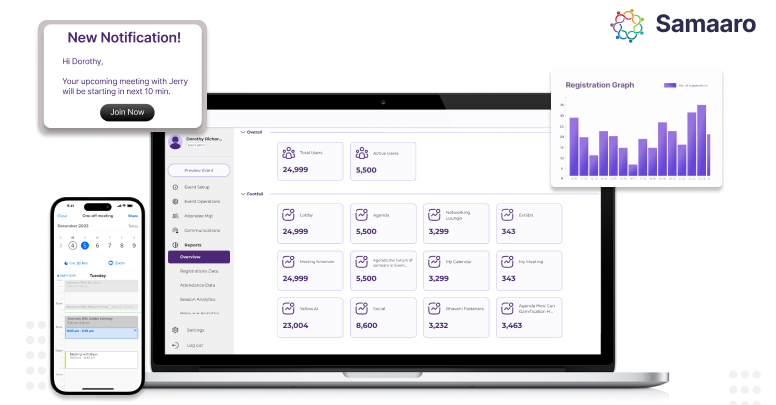
Ticket Sales and Attendance
Attendance figures and ticket sales are essential performance indicators that gauge the preliminary triumph of an event. By utilizing these metrics, one can quantitatively evaluate the extent and level of appeal of an event. Understanding attendance figures, however, necessitates a more nuanced examination than mere numerical data. By dividing attendee data into segments according to demographics, geographical locations, or registration sources, significant insights can be obtained regarding audience preferences and the efficacy of marketing approaches.
Analyzing ticket sales patterns, including an evaluation of the effects of various pricing tiers or discounts, can provide insights into the efficacy of the pricing strategy and its impact on the overall revenue generated by the event. Furthermore, an analysis of attendance patterns during the event, encompassing periods of high attendance or popular sessions, assists in the enhancement of forthcoming event timetables and the dissemination of content.
Online vs. On-Spot Registration Ratio: Measure the proportion of attendees registering online versus those registering on-site.
Revenue Distribution Across Ticket Tiers: Analyse the sales distribution among different ticket categories to identify revenue streams.
Sales Patterns: Weekday vs. Weekend and Time of Day: Assess ticket sales trends based on the day of the week and time slots.
Lead Generation and Conversion Rates
Events provide substantial prospects for the generation of leads. In addition to data collection, lead quality analysis is of utmost importance. A discrepancy exists between leads generated during an event. Prioritizing post-event follow-up efforts can be facilitated by evaluating lead quality according to criteria such as industry relevance, purchasing intent, and levels of engagement during the event.
The conversion rates obtained from prospects generated by the event offer clear and specific information regarding the influence of the event on the sales funnel. Gaining insight into the conversion journey, which spans from the initial interaction initiated at the event to the ultimate transaction, empowers organizations to detect obstacles or deficiencies in the conversion procedure. This knowledge empowers them to enhance their approaches to subsequent events.
Number of Qualified Leads Collected: Track the total count of potential leads gathered during the event.
Lead Conversion Rate from Event Engagement: Measure the percentage of event-generated leads that convert into customers.
Time from Lead Acquisition to Conversion: Determine the average duration it takes for event-acquired leads to convert into paying customers.
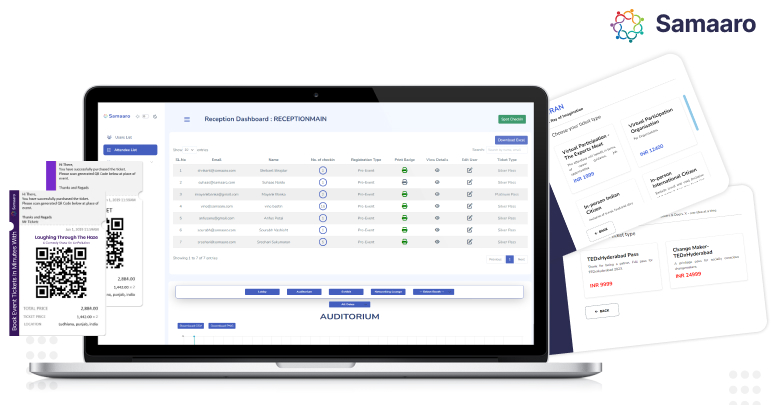
Engagement Metrics (Attendance, Duration, and Interactions of Sessions)
Evaluating attendee engagement metrics throughout an event yields invaluable insights regarding the most impactful content and activities for the attendees. Identifying the most captivating aspects of the event is facilitated by analyzing session popularity according to topics, speakers, or formats, in addition to monitoring session attendance. Moreover, an assessment of session duration or dwell times provides insight into the degree of audience engagement and curiosity regarding the presented material.
Conducting interaction monitoring throughout sessions or activities provides a holistic assessment of attendee engagement, encompassing responses to polls, queries posed, and networking connections established. By utilizing event technology, such as interactive tools or mobile applications, the capacity to assess engagement is significantly improved, and immediate event adjustments can be made based on real-time feedback.
Session Attendance Rate: Measure the percentage of registered attendees who participate in specific sessions.
Average Session Duration: Calculate the mean duration attendees spend in event sessions or workshops.
Number of Interactions per Attendee: Track the average count of interactions (questions, comments) made by each attendee.
Social Media Impressions and Reach
It is critical to utilize social media in the digital age to expand the scope of an event. In addition to physical attendance, reach, impressions, shares, and engagement metrics across multiple social platforms serve as indicators of the event’s digital prominence and influence. By monitoring particular hashtags or discussions pertaining to events, organizations can assess audience sentiment and online sentiment in real-time.
Additionally, conducting an examination of social media interaction prior to, during, and subsequent to the occasion offers a comprehensive assessment of the social impact of the event. It facilitates the identification of effective social media strategies, the identification of influential partners or attendees, and the development of future social media campaigns.
Total Reach and Impressions Across Platforms: Monitor the overall visibility and exposure of event-related content on social media.
Engagement Rate (Likes, Shares, Comments): Evaluate the level of audience engagement through likes, shares, and comments on event-related posts.
Sentiment Analysis: Positive vs. Negative Mentions: Analyse the sentiment of social media mentions related to the event.
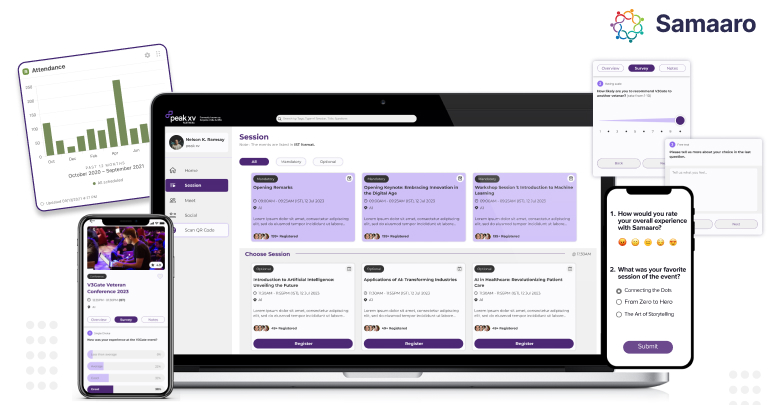
Customer Feedback and Satisfaction
The acquisition of exhaustive feedback from attendees via post-event surveys or evaluations is crucial for determining the level of customer satisfaction as a whole. Quantitative ratings yield a numerical evaluation, whereas qualitative feedback provides a more comprehensive understanding of the experiences, preferences, and areas requiring enhancement of the attendees.
The process of examining feedback trends among various demographic groups or attendee segments aids in the identification of recurring patterns and problem areas. This capability empowers organizations to customize forthcoming occasions in order to more effectively cater to the varied requirements of their attendees. Further, timely responses to constructive criticism foster confidence and allegiance among attendees.
Overall Satisfaction Score from Post-Event Surveys: Assess the general satisfaction level of attendees through post-event surveys.
Net Promoter Score (NPS): Measure the likelihood of attendees recommending the event to others based on a standardized scale.
Feedback on Specific Event Elements (Speakers, Content, Logistics): Collect feedback on specific aspects of the event to pinpoint areas for improvement.
Post-Event Conversions and Sales
It is critical to monitor sales and conversions in the aftermath of an event in order to ascertain its enduring influence on business results. By examining the purchasing behavior of attendants after the event, such as conversions and follow-up interactions, one can establish a link between event attendance and measurable business outcomes.
Revenue Generated Post-Event: Calculate the total sales or revenue directly attributed to the event after its conclusion.
Conversion Rate of Post-Event Leads: Measure the percentage of leads acquired during or from the event that convert into sales.
Upsell or Cross-Sell Opportunities Identified: Identify additional sales or upselling opportunities realized post-event.
Pre-Event Organization Techniques: Adapt event strategies in accordance with objectives. To maximize impact, employ targeted marketing strategies such as audience segmentation and personalized communication. The utilization of attendee data from previous events facilitates the improvement and targeting of strategies.
On-Site Engagement and Interaction: Foster active involvement by implementing interactive sessions, networking opportunities, gamification, and immersive experiences. Participation is increased by utilizing technologies like virtual reality and event applications. Collaboration is enhanced through the use of networking activities, live polls, and question-and-answer sessions.
Post-Event Follow-Up and Analysis: Utilize the gathered data and feedback from attendees to conduct an exhaustive analysis. Insights should be utilized to improve future events. Follow up with prospects in a timely manner to convert potential opportunities and capitalize on generated interest. By delivering exclusive post-event content or offers, attendance is further increased.
Beyond quantifying returns on investment (ROI), event evaluation entails understanding the extent to which an event contributes to the fulfilment of organizational goals. By placing emphasis on these six critical metrics, combined with strategic planning and post-analysis, organizations can enable their events to achieve their maximum capacity and generate concrete, measurable outcomes. Assessing return on investment (ROI) encompasses more than a simple evaluation of the event itself; rather, it is an ongoing procedure that involves developing strategies to ensure long-term success in subsequent events.

Built for modern marketing teams, Samaaro’s AI-powered event-tech platform helps you run events more efficiently, reduce manual work, engage attendees, capture qualified leads and gain real-time visibility into your events’ performance.


© 2025 — Samaaro. All Rights Reserved.